#How To Use these Top 5 Distortion and Overdrive Pedals
Explore tagged Tumblr posts
Text
How To Use - Top 5 Distortion and Overdrive Pedals
The Top 5 Distortion and Overdrive pedals you can buy easily, and just about anywhere. These are the some of the best drive tones you can purchase today. And not a boutique pedal in sight!
This list gives you what I believe are the most flexible, reliable, and readily available stompboxes. If you need a good overdrive or distortion for your guitar setup then this is the list for you and I’ve added a few basic tips to get the most out of each pedal. Ultimate Drive Tone? I have a huge collection of pedals myself and have been using pedals for over 35 years. This has given me some…
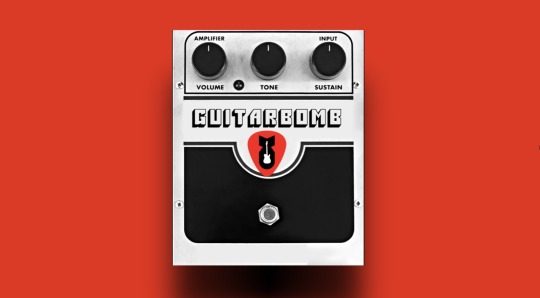
View On WordPress
#Booster#Boss#Boss BD-2 Overdrive#Boss DS-1 Distortion#Boss SD-1. Boss#diodes#distortion#fuzz#germanium diode#hard clipping#How To Use#How To Use these Top 5 Distortion and Overdrive Pedals#How To Use Top 5 Distortion and Overdrive Pedals#Ibanez#Maxon#MXR#MXR Distortion +#MXR Distortion Plus#Nobels ODR-1 BC#overdrive#pedal#preamp#ProCo#Proco Rat 2 Distortion#soft clipping#stompbox#Top 5 Distortion & Distortion Pedals#Top 5 Distortion Pedals#Treble Booster#TubeScreamer
0 notes
Text
Top 5 Guitar Effects // First Article
5 Guitar pedals any guitarist should have on their board.
The 5 most important effects any guitarist should have on their board Over the years, effects have become irreplaceable tools of expression for many guitarists and we’ve lined up the essentials.
1. A distortion, fuzz or overdrive
Whether you prefer the fuzzy overtones of a ‘Big Muff’ pedal or prefer the cut of a modern distortion, there’s nothing wrong at all for having some extra power up your sleeve. As many of you know, guitar players have a desire to get loud, fast and flashy, and one of these pedals will surely get you there.
2. An equalizer pedal
No matter how much time you put into your guitar solo, it’s no good if nobody can hear it! Equalizer (or EQ) pedals are an easy way to shape your sound, and give it a boost at the same time! Many guitarists use this as a way to increase their midrange and cut through the mix, but you can also use it to thicken up those fat bass notes.
3. An Echo or a good Reverb
An Echo can turn an ordinary lick into a haunting melody. Almost all guitarists agree that Reverb and Echo are essential to a good guitar sound. Not only the clean and ambient pieces benefit, but the face melting solo’s also do well with a bit of echo. A decent echo can also thicken up the sound, or make transitions seem more fluid.
4. A Wah-wah pedal
Perhaps the most famous of all effects. Where would Jimi Hendrix, Slash or Kirk Hammett be without their wah pedal? If you feel the need to wail, scream or make your guitar cry, you need a Wah-Wah pedal in your life. While using one may require a bit of getting used to, the options are endless when you master the art of wah
5. A tuner pedal
Don’t make your audience, roommate or pet listen to an out of tune instrument. Tuner pedals are relatively inexpensive and prevent you from being horribly out of tune. Note that many tuner pedals also function as a quick mute button!
2 notes
·
View notes
Text
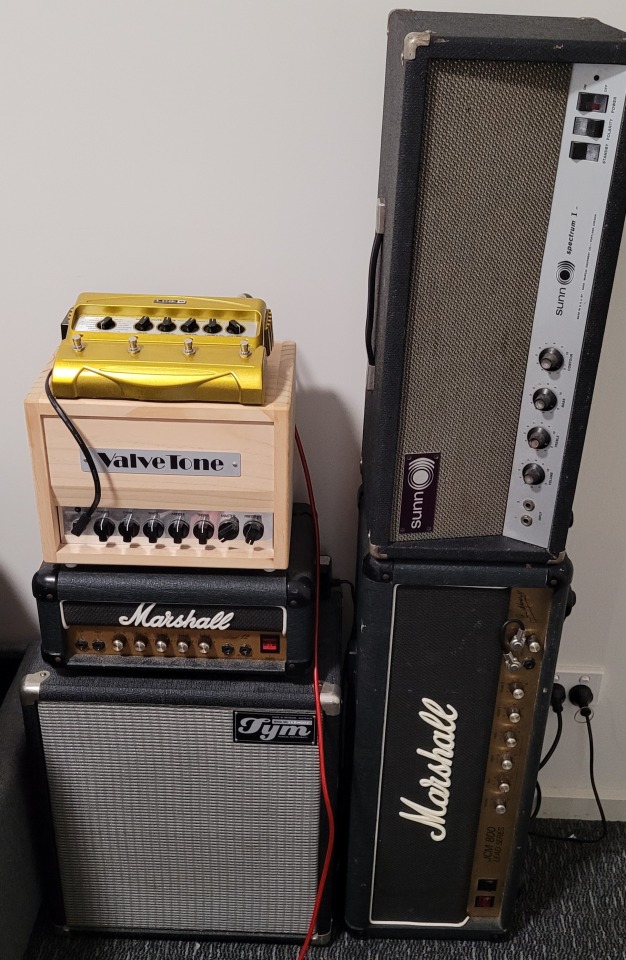
Been doing a lot of cleaning and organising in the apartment lately and it's come to my attention that I own a lot of amps. Clockwise from top left:
Valvetone Juno 25: 25w tweed Bassman clone, handmade in Newcastle by the guy that used to make Baez amps. Of all these this is the one I tend to play through the most, it covers so much ground, gets along with every pedal you put in front of it and the older I get the more I like Fender gear/stuff based on it.
Sunn Spectrum I: Made for one year only, this 1967 Sunn is the absolute king of cleans. It only gets along with about 1 in 5 overdrives or distortions but it LOVES fuzz. These old Sunns have incredible harmonics, it's the sort of thing you usually need a preamp or a tone scrubber to get but it's right there in the box. Fitted with an aftermarket transformer that limits the output to around 30w and given how loud it is at present the last thing it needs is more power.
Marshall JCM800 1984: Not made in 1984, 1984 model. It's an early 80s build so not far off, though. Basically a 50w Plexi with more gain. One of the inputs is a master volume knob now, and the work done to get this back to stock was nothing short of a rescue mission as it was in terrible shape when I first got it - red-plating, putting out barely any volume - but now it kills.
Marshall Lead 12: Little 12w solid state baby amp from the 80s. Sounds decent when plugged into a cab on its own but as a preamp this thing is incredible, and I am so happy I discovered that before selling it. Lining this into my cheap Champ clone (not pictured here) makes for a hell of a recording setup.
*Line 6 DM4 included to annoy snobs - I love that thing.
1 note
·
View note
Text
We could become slaves to our equipment...volume 2
WARNING: GUITAR GEEK LANGUAGE FOLLOWS
David Lindenbaum is the second half of the Pigs on the Wing guitar team and an accomplished solo artist in his own right ( check out his solo album Ether Day if you have done so yet). While Dave is an old hand at performing Pink Floyd’s music, he actually came into the band a bit later - as Pigs on the Wing began life as a single-guitar band in the spirit of the original Pink Floyd. A seasoned and infinitely adaptable musician, Dave played his first gig with Pigs on the Wing as sub bassist - before convincing the band ( rightly so) that they really needed a 2nd guitarist. Today we’re going to take a look at Dave’s guitar setup for Pigs on the Wing - and the equipment he uses to achieve the classic Pink Floyd guitar tones.

Dave onstage with Pigs on the Wing in 2015
POTW: What is your approach in general terms to getting the David Gilmour sound ? Do you ever improvise or do you tend to play the parts note for note?
DAVE: As for as his sound, I shoot for something in the right ballpark. I’ve never tried to replicate his exact gear or anything, but have rather tried to stick to the spirit of it. For the parts I go mostly note-for-note, leaving windows here and there to be spontaneous. Here again, when I improvise I tend to stick with my perception of the spirit of the music. Once in a while I just cut loose and play off the top of my head, usually during sections where we’ve added jams that aren’t in the original arrangements.
For iconic stuff like the Brick Pt. 2 or Time solos, I play those note-for-note, figuring that fans expect to hear them that way, and also that I can’t improve on perfection. On lesser known stuff I’m more open to interpreting or improvising.

Pigs on the Wing in 2012
POTW: You came into this project after it was established, originally as a 1 guitar band - what was the process like for finding a place for both guitarists ?
DAVE: For me it was mostly a process of playing as little as possible at first and waiting to be invited to add more. I’ve always been a collaborative player, and think of my self as primarily a colorist, so that process happened naturally for me. Over time we had conversations about me taking on some of those iconic note-for-note parts since I knew many of them already. Jason likes to be a little looser and keep things a little more spontaneous, so we evolved organically into roles that suit our strengths as players. We sometimes have guitar practices where we go through each song and fine-tune our parts and how they work together. Generally we try to err on the side of leaving more space and playing less.
I’ve also become the de facto utility player, handling acoustic, lap steel, and other miscellaneous parts. Again this plays to our respective strengths because Jason mostly likes to play electric, whereas I grew up playing 12-string, nylon-string, and things like that. I learned to play songs like Fearless, Is There Anybody Out There?, and Wish You Were Here as part of learning guitar when I was a teenager, so it was natural for me take on that role in the band, to fill that need, if you like.
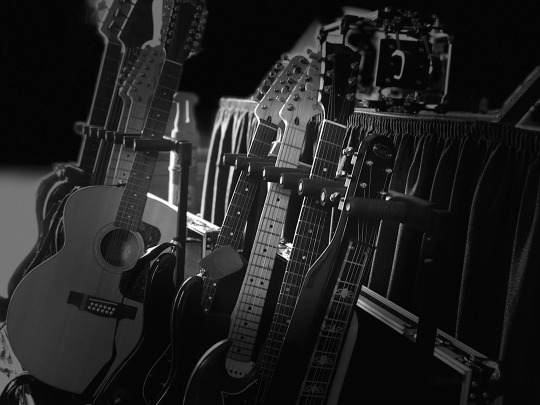
POTW guitars - onstage - 2018 Finding the Dark Side of the Moon tour
POTW: Let's talk about your guitars. Tell us about your main instrument(s) and why they work for this project.
DAVE: I’m pretty much a maple-neck Strat guy generally, probably because my first decent guitar as a kid was a Japanese Squier Bullet, a 3/4-size Strat body with a maple Tele neck. I played that guitar for 11 years before finally getting a Strat, so by then nothing else felt right in my hands but a Fender with a maple neck! Plus I think they’re more versatile than most other guitars. With the right pickups you can play any style of music with a Strat. I also like that Strats are a bit harder to play than other electrics. They make you work a little harder, so when I dig in things don’t get chaotic, unless I want them to. Over the years I’ve had four different Gibsons - a Les Paul, SG, Firebird, and ES330TD, in that order - and ended up selling all of them eventually.
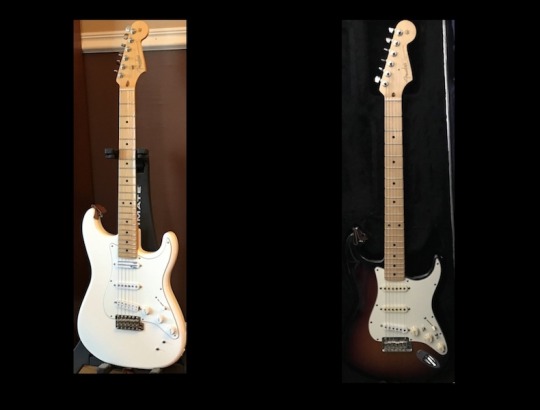
Dave’s Stratocasters
I just got a new Strat that is quickly becoming my main electric - an Ed O’Brien (from Radiohead) signature Strat. It comes stock with pretty much all of the stuff I would want to mod a Strat with, like a Sustainer pickup and a mini-humbucker in the bridge, a Little JB. I had locking tuners put in and had it set up for 10s. I also ended up swapping necks with my now-former main Strat because the stock 21-fret V neck felt weird after 33 years playing C necks, most of which had 22 frets.
I love my Ebow, so the idea of the Sustainer was very appealing to me. I use it on Echoes and plan to use it extensively on Shine On when we bring that back into the set later this year. My now-backup guitar is a heavily modified 2011 sunburst American Standard Strat. I put a Duncan STK6 in the bridge, wired in a coil-tap switch, and put in a switch to add the neck pickup to the bridge out-of-phase. It also has a bone nut and locking tuners. As noted above, it now has the 21-fret V neck from the Ed O’Brien.
I use a Guild 12-string for all steel-string acoustic parts, except for Dogs, for which I play an old Yamaha 6-string tuned to D standard. I play a Yamaha nylon-string acoustic-electric for three songs on The Wall. I also play a Supro 6-string lap steel guitar in drop-D tuning for slide parts.
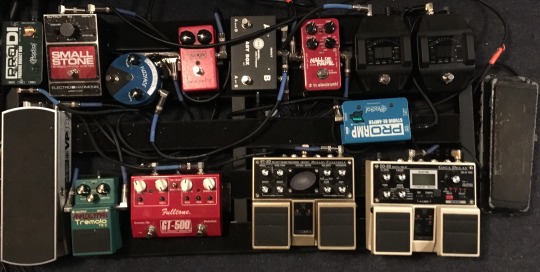
Dave’s pedalboard setup as of Sept 2018
POTW: How do you generate the distortion and overdrive effects ? Do you use a Big Muff ? How about the Leslie effects? What is the most irreplaceable pedal on your pedalboard ?
DAVE: I mostly use a Fulltone GT500 for distortion. I really prefer amp gain, but somehow ended up going this route a few years ago.
I recently incorporated a backwards-plugged wah to my setup for the creepy whale sounds on Echoes and Is There Anybody Out There? It works great unless you happen to use wireless, so I ended up adding an A/B switch so I can use a cable with the wah and wireless for everything else. I recently got a 5 channel looper pedal with an A/B so the current A/B will go away. It’s like Medusa’s head of snakes - every time I get rid of something, 2 more things take its place!
I have a Boss RT20 rotary speaker pedal that I like a lot. It’s versatile and indestructible. I also have three Analogman-modded pedals that I love - a Small Stone phase shifter, a VPJr volume pedal and a Boss TR2 tremolo. The most indispensable pedal on my board is definitely the Boss DD20 delay. Many Floyd songs are dependent on delay for tempo, so a good-sounding, reliable and programmable delay is crucial, and the Boss is all of those things; and like the RT20, really all Boss stuff, it’s indestructible. Our stuff takes a fair amount of abuse so roadworthiness counts for a lot.
POTW: Gilmour was known for playing through 100 watt Hiwatts at very high volume - what's your amp setup these days, and how is it similar or different from Gilmour's?
DAVE: I’m using a 1967 Fender BandMaster Head with two identical Avatar 2x12 8-ohm cabs. They are of the now-discontinued Vintage Diagonal series, which means the speaker board is mounted on a slight upwards tilt to facilitate being easier to hear on stage. They each have one Vintage 30 and one G12H30 speaker. I have to give a big shout-out to Avatar for making me a second cab to my specs despite discontinuing both the model in particular and custom orders in general.
My setup is different from Gilmour’s in that it is significantly lower wattage - 50 compared to a couple hundred or more, depending on how many heads he uses nowadays - and I play at a comparatively low volume. Similar to Gilmour, my rig is set up for clean headroom as opposed to high gain.
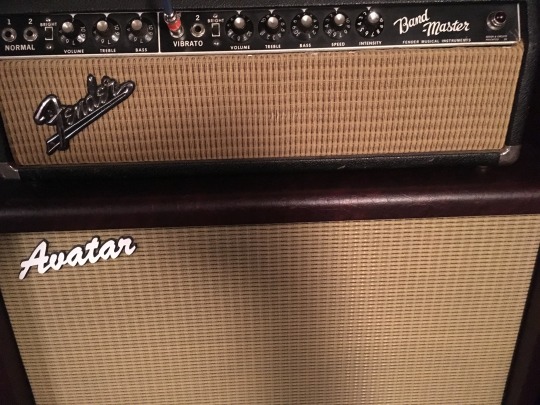
Dave’s amp rig - Sept 2018
POTW: On that note - how is your rig similar or different from Jason's rig ? Is it ever chaos having 2 guitars on stage at the same time ? How do you guys create space for both instruments ?
DAVE: My rig is very different from Jason’s in a couple of ways. He uses an Orange head into a Marshall 4x12, and uses the effects loop for his pedals. His amp has a high gain channel that he uses for most of his leads. My rig doesn’t have an effects loop so my pedalboard runs straight into the amp. Jason uses cables, whereas I am wireless.
On the other hand, we both have pretty similar pedal layouts, including 2 or 3 of the same pedals, and we both use tube amps. I started using Gilmour-style short trem arms after seeing how much Jason liked his, and Jason turned me on to Analogman pedal mods.
It can be a little chaotic with the two of us, especially on really loud and jammy songs like Interstellar Overdrive or the middle part of Echoes. As mentioned earlier, we put a lot of time into arrangements so we don’t step all over each other. It helps that neither of us are showboats or egotists. We’re pretty mellow and considerate. And sometimes a little chaos is a good thing! Mostly we try to avoid having our combined stage volumes blow out the eardrums of our band mates, our audiences, or ourselves, and/or irritate Shira, our FOH sound engineer.

Pigs on the Wing live 2018
POTW: Last question: Boss or EHX pedals ?
DAVE: Yes, please. I am an equal-opportunity pedal nerd.
#pigs on the wing#pink floyd#analogman#fender#stratocaster#david gilmour#guitargeek#pink floyd tribute
3 notes
·
View notes
Text
Ultimate Guitar Pro App

If you are looking for the best guitar apps, the 2021 is looking bright for you. Today we are going to talk about some of the top-rated learning Android and iOS guitar apps for beginners, both free and paid ones. We’ve made sure to include the apps that are as efficient as they are user friendly. So, without any further ado, let’s get straight to it.
Ultimate Guitar Pro Sign In
Ultimate Guitar Pro App Free
Ultimate Guitar Tabs Pro App
Ultimate Guitar Pro Tab
Here are the best guitar apps 2021:
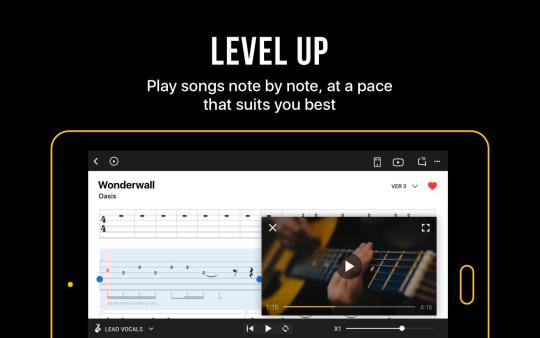
Your #1 source for chords, guitar tabs, bass tabs, ukulele chords, guitar pro and power tabs. Comprehensive tabs archive with over 1,100,000 tabs! Tabs search engine, guitar lessons, gear reviews. The Guitar Pro application allows all musicians to view and play sheet music and tablature created with the famous Guitar Pro tab-editing program for Windows and Mac. This mobile version is the ideal companion for you to practice your favorite songs and share them any time, anywhere! Coming up with some arpeggio, a riff, a chord sequence?
1. AmpliTube
The AmpliTube is loved by beginners just as much asexperienced guitar players love it. It’s an app that can be used to do prettymuch anything; from playing around with different sounds, over tuning, torecord demos and actual songs.
This app is actually more of a studio as it boasts a broad selection of virtualized sound models from world-famous guitar gear. Furthermore, it’s not a type of guitar application built exclusively for guitarists, as bass players can use it just as well.
Despite the fact that it has a ton of pretty cool features, it is still quite simple to use. Most of the work can be done with the easy drag-n-drop method, although you will need some experience with actual amps and effects if you want to find proper sound models.
AmpliTube rocks a wide variety of stompbox effects,including delay, fuzz, wah-wah, chorus, flanger, overdrive, octave, phase, anddistortion. On top of that, you’ll be wiring the effects via five amps, fivecabinets, and two microphones. It’s quite safe to say that you will be able tofind the sound you are looking for with it.
This guitar app is essentially free; you will get the Custom Shop, the app, and a dozen gear pieces to start, but the ‘expansion gear’ costs a couple of dollars apiece. AmpliTube might be the best guitar app for iPhone/iPad users.
Image credit: IK MultimediaCheck App Store
A huge selection of effects, amps, and cabinets.
Quite simple to use.
Drag-n-drop mechanism.
Very authentic sounds.
2. PocketAmp
PocketAmp is exactly what it sounds like, it’s a portable amp device which doubles for an actual amp if you have any kind of instrument adapter. If you are looking for an app for learning how to play guitar, this one shows quite a bit of promise.
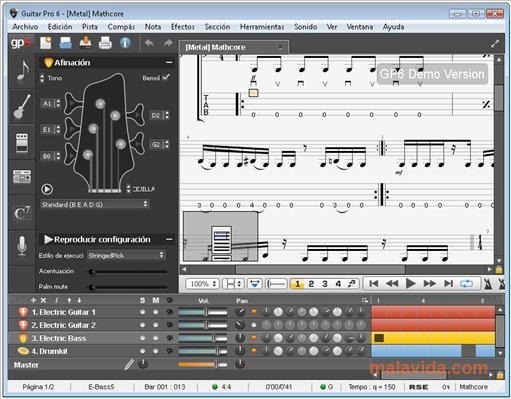
Basically, you’ll need a plug which would convert your guitar cable’s jack into a smartphone-compatible jack, plug your guitar into your phone, and start the amp. From there you will gain access to four different amps, seven guitar pedal effects, and four cabinets.
You will probably be surprised to find how authentic the tone of PocketAmp is, however, going overboard with distortions and overdrives might thump your speaker, so try to avoid going too crazy on it.
The best thing about this guitar app is that it allows you to simulate an entire guitar rig directly from your phone. Although it isn’t free, it’s available at a rather attractive price. It’s a massive, and probably one of the best apps to learn guitar for beginners.
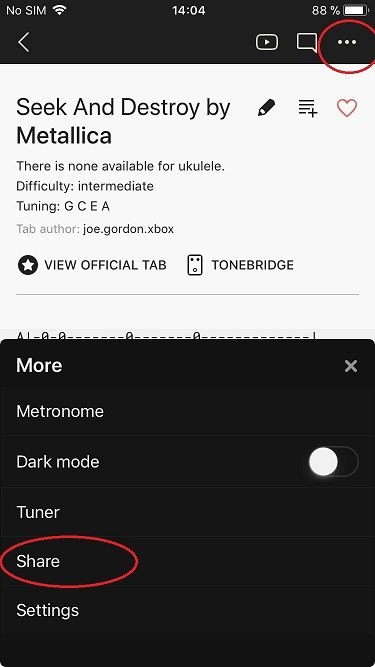
Image credit: PocketlabworksCheck App Store
Very easy to use.
Packed with four cabinets, seven effects, and four amps.
High-quality tone.
Perfect for beginners and novice guitar players.
3. OnSong
The OnSong is a guitar app made for performingguitarists. It’s basically a chord chart app which was intended to replacephysical chord charts with digital and interactive ones.
There are many musicians who struggle with memorizing dozens of songs, especially if they are complex in nature, that’s where OnSong comes in. It has a massive storage capacity where you can store huge chord chart collections and access them quite easily.
Furthermore, it’s compatible with various online store apps, such as Dropbox and Cloud; you can use these to import your songs directly to the OnSong app. To utilize this app’s full potential, combine it with a foot pedal; then you will be able to scroll down your charts hands-free. It’s easily one of the best guitar apps for iPad out there.
Image credit: OnSongCheck App Store
Simple and straightforward to use.
Huge song chart storage.
Compatible with online storage apps.
Perfect for live performing musicians.
4. Play Guitar Hits
The Play Guitar Hits is one of the most well-rounded guitar apps you can find on the App Store. It’s completely free to download, doesn’t take up much space, and you’ll get a variety of features at your disposal.
One of the best things about Play Guitar Hits app is that you can customize the interface to best suit your preferences. You can choose between standard tablatures, slash, and the classic fretboard view.
What makes Play Guitar Hits different from other guitar apps is that it offers a highly interactive learning mode – you will get to learn your favorite songs and techniques while watching play-through videos.
Simply put, the Play Guitar Hits comes with a dual-screen feature: on one side you’ll see the interactive tablature while on the other side of the screen you’ll see a play-through video of your song (if it’s available).
Furthermore, you will get the opportunity to choose different levels; the fact that there are four selectable ‘experience’ levels means that this guitar app offers a unique and entertaining mode of progression.
Of course, you will always be able to halt the tracks if you think that you should practice certain parts a bit more. Additionally, you can morph songs into backing tracks and practice with isolated instruments for a better, real-time feeling.
The Play Guitar Hits is a very versatile guitar application that you can download for free on the App Store; it’s certainly one of the best guitar learning apps available on the market, as well as among the best free guitar apps.
Image credit: Play Guitar HitsCheck App Store
Remarkably easy to use.
Comes with a couple of demo songs.
Versatile video display positions.
Four selectable levels.
Dissectible song parts makes practicing easier.
Available for free on App Store.
5. Anytune
Anytune is not your average guitar app. It’s uniquein a way that it lets you play around with different tempos of the songs, butwithout interfering with their pitch.
Ultimate Guitar Pro Sign In
The value of this guitar app actually depends on how you use it, and luckily, it has a nearly limitless potential. You will be able to slow the songs down if you’re struggling to nail certain parts, or speed them up to experiment. Additionally, you can start a bit slower and pick up the tempo as you go.

Ultimate Guitar Pro App Free
Image credit: AnytuneCheck App Store
Quite fun to use.
Simple guitar app, great for beginners.
A couple of unique features.
Available for free on App Store.
6. Ultimate Guitar: Chords & Tabs
Ultimate Guitar is one of the most famous guitar tablature websites on the internet, and if you are looking for a quality app, you might as well start with this one. This guitar app boasts the largest chord & tab database, so it’s pretty safe to say that whichever tablature you were looking for, you can find it here.
The Chords & Tabs app comes supplied with GuitarTools pack which is comprised of a metronome, a tuner, and a personalized chord library. Most beginners start out by using Chords & Tabs and find themselves browsing through the vast tab database even years later, so it’s easy to say that it’s perfect for both beginners and pros.
With the auto-scroll feature, the UG Chords & Tabs is a perfect tool for home practice. Moreover, it’s available for free on the App Store and Google Play. If you happen to like what it has to offer, you can upgrade to Ultimate Guitar Pro with the in-app purchase of additional content.
Image credit: Ultimate GuitarCheck App StoreCheck Google Play
Huge tablature and chord database.
Intuitive interface, very easy to use.
Perfect for both beginners and professional guitarists.
Loads of interesting features.
Available for free.
7. Fret Trainer
Ultimate Guitar Tabs Pro App
Fret Trainer is an app designed for beginner guitarists, that much is certain. It’s an application that utilizes different ‘games’ to help new players understand the basics.
You will be able to switch between severalinstruments and game modes, including the scale explorer, name note, colormatch, staff and fretboard, and many others.
Ultimate Guitar Pro Tab
Although the game appears to be somewhat childish and focused on the younger population, it actually uses the simplest method to teach something that is taught in very specialized schools for years on end. If you’re looking for the best guitar lesson apps, feel free to check out the Fret Trainer.
Image credit: Strong AppsCheck App StoreCheck Google Play
Incredibly simple to use.
Intuitive UI.
Very entertaining, several game modes available.
Perfect for beginner guitarists.
Available in iOS and Android.
8. Guitar Pro
Guitar Pro is, hands down, one of the best guitartab apps that you can find. It might take you some time to get used to theinterface, but once you do, it will feel so natural to you that you’ll wonderwhy you even ever considered any other app before.
The Guitar Pro app is packed with features that are equally useful to both musicians and song composers. You will actually be able to learn a great deal of music theory by just using this app.
The Guitar Pro application is built in the spirit of GP’s desktop variant, although there are very little similarities between them in terms of user’s interface. You’ll be able to pack several different instrument tracks on top of each other and tweak them to perfection. The only downside is that Guitar Pro uses MIDI, which might not appeal to everyone.
Image credit: Guitar ProCheck App StoreCheck Google Play
Quite easy to use.
Available at a bargain price.
Incredible versatility.
Educational tool for learning music theory.
Great for musicians and composers.
9. Fender Tune
Fender is a huge name in the guitar world, and obviously enough, their tuner is one of the best guitar tuner apps that money can buy.
In anutshell, this is a simple app which can be expanded with in-app purchases;initially, it offers the Pro Tuner, Rhythm, Scales, and Chords modes. The tunermode itself offers automatic tuning and manual (tune by ear) options.
Aside from being a very reliable tuner, all of the other features of the Fender’s Tune app are quite great too. You’ll be able to learn quite a bit of scales and warm-up exercises with it, as well as discover the vast world of music theory.
Image credit: FenderCheck App StoreCheck Google Play
Very easy to use.
Versatile app packed with several features.
Superb for beginners.
Available for iOS and Android.
Final thoughts
Even though some guitar players might tell you that learning how to play a guitar is tough, it’s actually quite easy. At least handling the fundamentals is. The truth is, it’s up to you to decide whether you will take an easy road, or a hard one. By using the apps we’ve suggested, you’ll certainly thread on the former.

0 notes
Text
Highlights from Walter Becker’s Estate Sale

Walter Becker’s guitar estate sale was listed recently, and boy howdy is it a fuckin’ doozy.
If you’ve followed along during any of my numerous Steely Dan binges, you’ll know that Becker was a god in the studio...whether on bass, guitar, behind the board, mixing, composing and arranging, or leading a band of the finest musical mercenaries you could hire...and his collection of gear is exactly what you might imagine a musician like that would have around.
There are some crucial pieces missing...I’m assuming the most important parts of his collection stayed within his and the Steely Dan family...but overall, it’s just preposterously awesome.
Notes and my picks of the litter after the jump...
***
Make no mistake, this is excess. The sheer number of vintage Gibson archtops for a guy who never recorded with them is kind of grotesque.
Becker was clearly compulsive. He has Fender replicas in the exact same color schemes, with the same pickups because...likely...one of these custom builders’ guitars found a way into his hands and he bought six of them in his favorite styles, and likely thought “this is the best Fender I’ve ever played.” Soon they’d find themselves in storage next to his vintage original Fenders, as the next flavor of the month came along.
The amps...it’s just absurd. One watt, one hundred watts, 8x10″ speakers, 1x8″ speakers, every make, model, color, combo, you name it. The sheer physical space that amp collection must have taken up is hard to imagine. He’s got like half of a page dedicated to his Fender Champ collection alone.
It’s redundancy on top of redundancy on top of redundancy. That said, all of it...every, single, piece...is something a guitarist or bassist would drool to have in their arsenal. Lets get to my favorites...I kinda broke it down by general category.
***
THE “FENDERS”
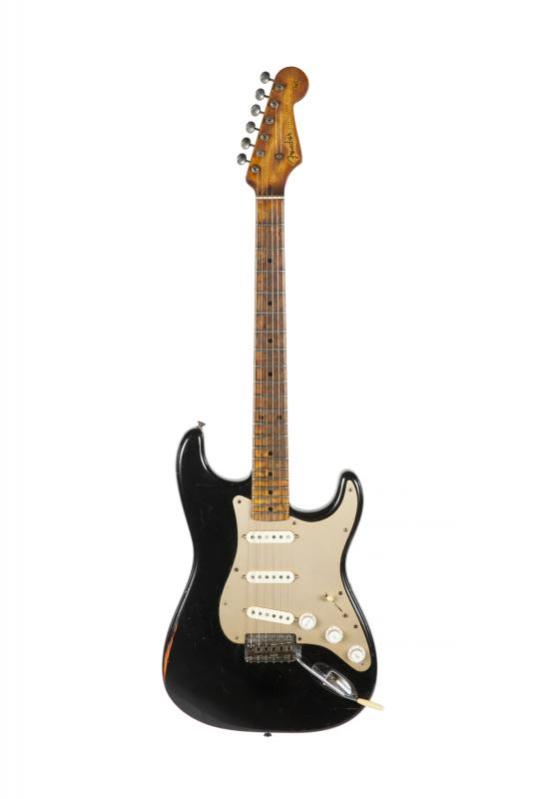
1954 Fender Stratocaster (est. winning bid $10,000-15,000)
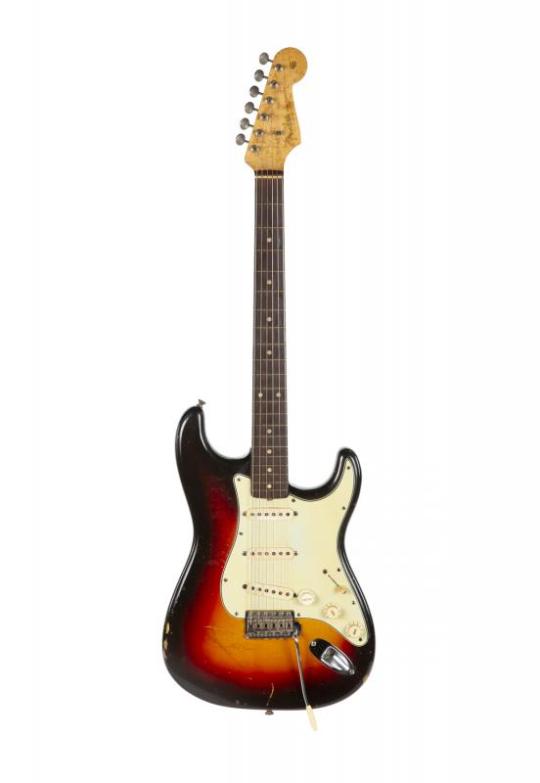
1961 Fender Stratocaster ($10,000-$12,000)
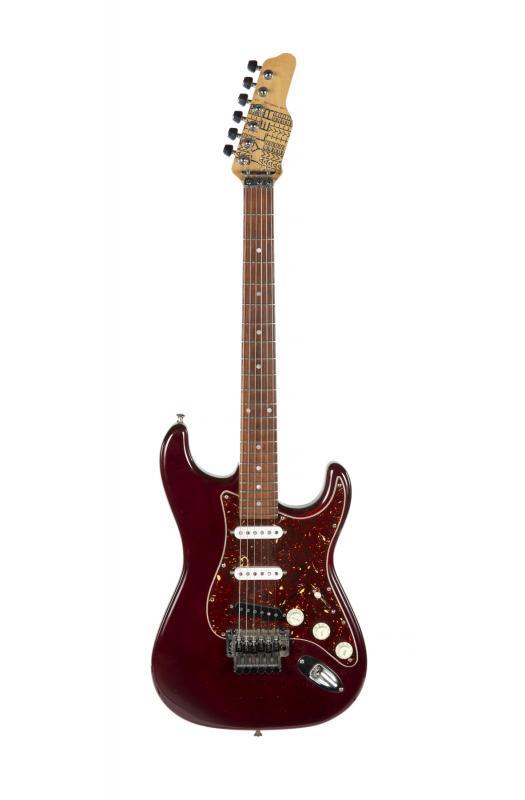
James Tyler Custom ($3,000-$5,000)

“Danocaster” Telecaster ($1,000-$2,000)
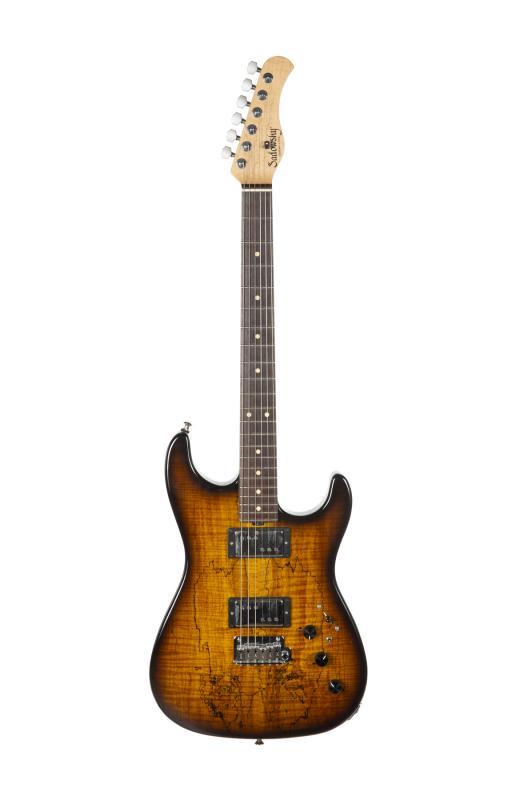
Sadowsky Custom Telecaster “The Dumpster Guitar” ($2,000-$3,000)
Notes: Vintage Fenders are the fucking best. The Tyler is the backup to the guitar you see at the top of the post...James Tyler was one of the first guys to make these insane “Fender on Steroids” guitars, and if you’ve ever played one you’ll know how crazy it is that, even today with the spectacular boutique builders around, the quality of his guitars is almost unmatched.
“Danocasters” are Fender-style instruments put together by this guy who started his business on a heavily populated guitar forum. Superb attention to detail, really well done pieces, and he just retired so his guitars are insanely overpriced. Getting Walter Becker’s in that price range would be about 1/2-1/3 of what they’re going for used since then, and I’m sure that the estimated price reflects the sudden and dramatic uptick in the market. There are some basic, no-frills Danocaster Strats and Teles on the used market going for substantially more than $5,000...and this is a semi-famous guy’s.
The “Dumpster Guitar” is named for a hissy fit Walter threw when he was playing a particularly shitty show. At the break, he threw it in the dumpster outside the club they were playing...but then later felt bad and had one of his techs go get it.
***
THE GIBSONS
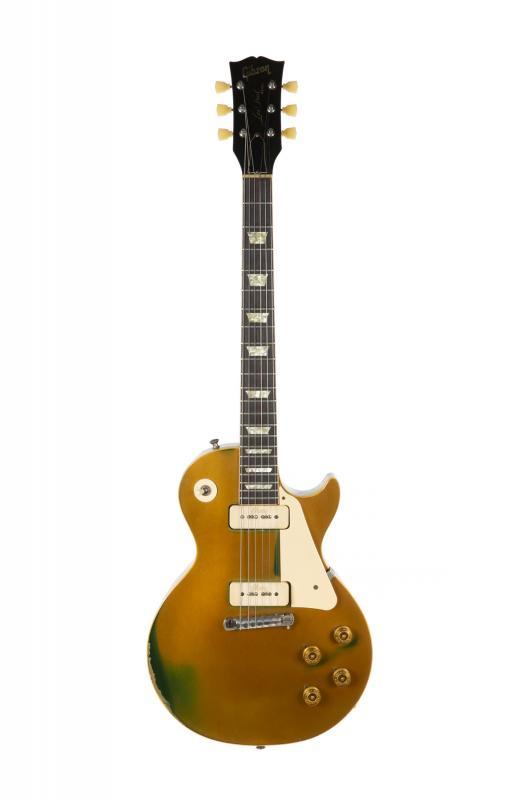
1971 Gibson “1958″ Les Paul Standard ($3,000-$5,000)
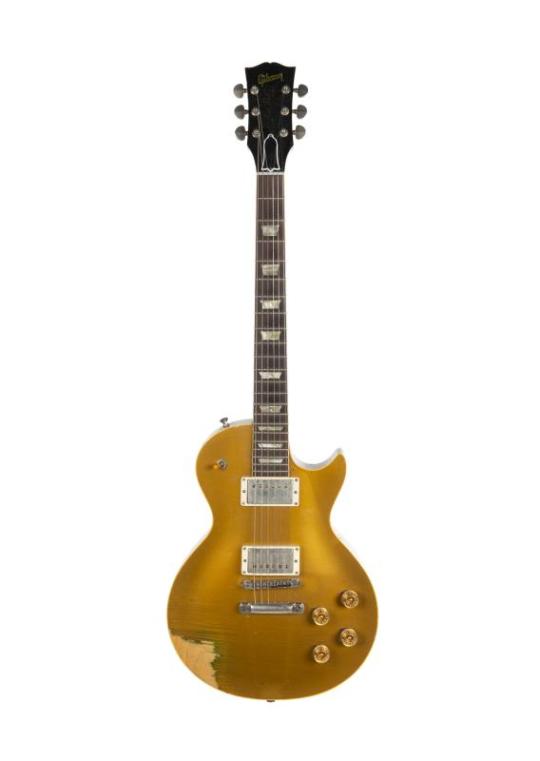
1953 Gibson “1958″ Les Paul Standard ($10,000-$15,000)
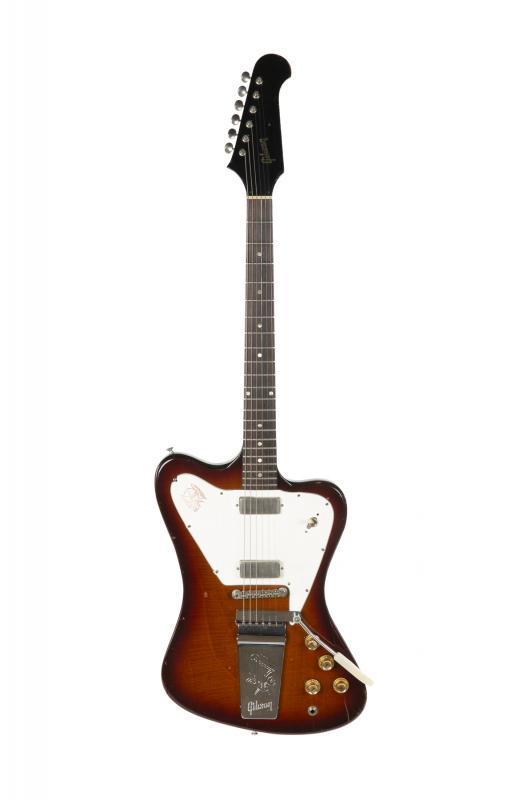
1965 Gibson Firebird V ($2,000-$4,000)
NOTES: The two gold top Les Paul’s are pretty funny, if you’re into the whole “nerd” thing. In 1971, there wasn’t this library of knowledge about vintage guitars like there are today. Hell, in 1971, all these guitars and basses weren’t even old enough to be considered vintage in the first place.
So in 1971, Gibson came out with “1958 reissues.” The guitar that they came out with...seen above...is a 1954 Les Paul, not a 1958. A 1958 would have had a sunburst finish, two humbuckers and a two-piece stop tailpiece, not the wraparound.
Well, whatever numbers Gibson put on that model are irrelevant, because Becker had his 1952-54 Les Paul with P90′s...so he took his 1953 Les Paul with P90′s and turned it into a 1958 (with a gold top). The ‘53 (’58 conversion) is my belle of the ball.
Firebird included because Becker was one of the most famous Firebird devotees.
***
THE BASSES
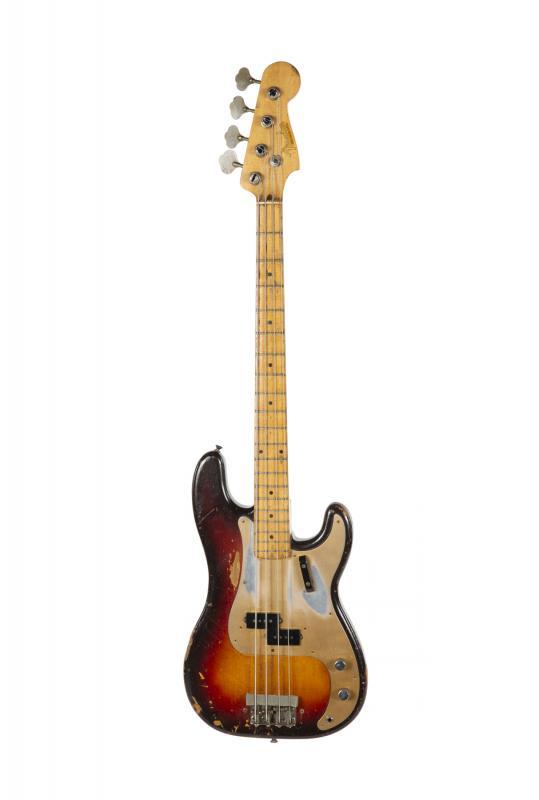
1958 Fender Precision Bass ($8,000-$10,000)
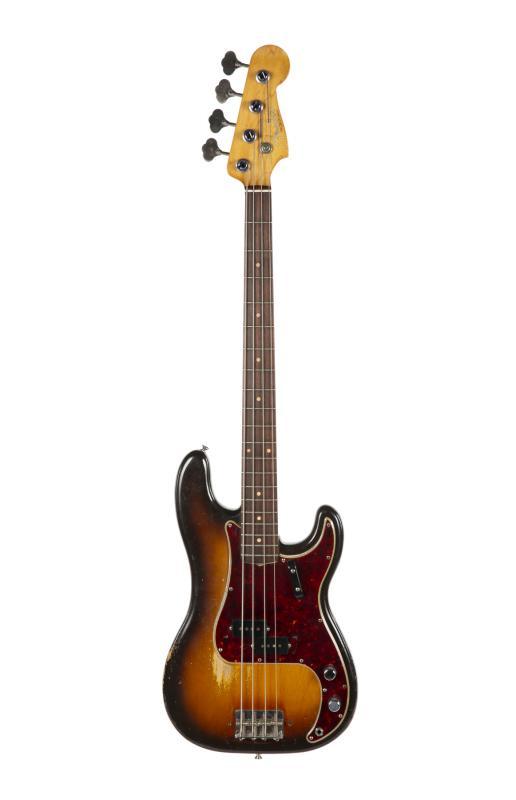
1959 Fender Precision Bass ($8,000-$10,000)
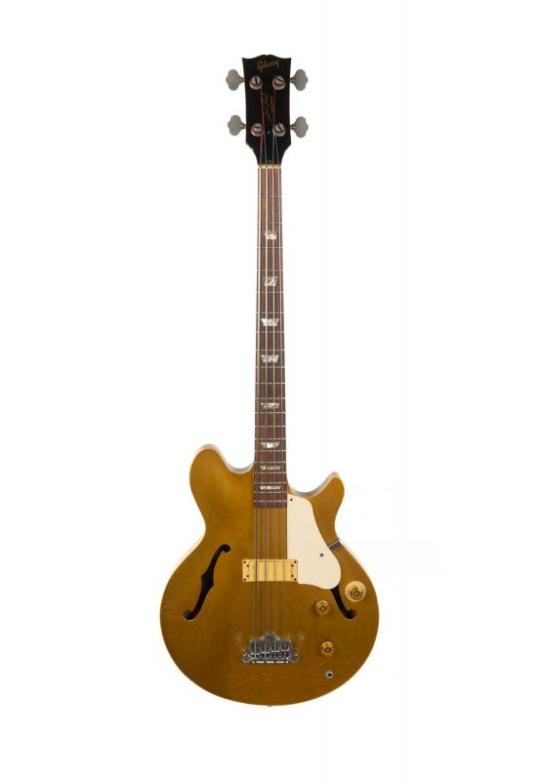
1970′s Gibson “Signature” Bass ($2,000-$3,000)
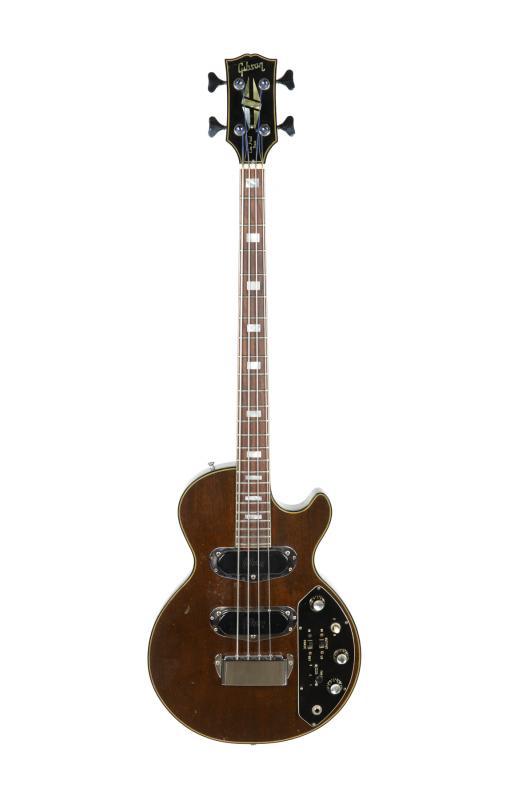
1970 Gibson Les Paul Studio Bass ($1,000-$2,000)
NOTES: Walter Becker was a P-Bass icon...if you’ve heard “Deacon Blues,” you’ve heard that 1958 P-Bass. I’ve said so much about P-Basses for a reason...in the studio, they are the undefeated kings. It’d have been more of a surprised if a studio god like Becker didn’t have a P-Bass in the mix.
Unfortunately, you’ve heard that hideous disgusting monstrosity at the end more times than I feel comfortable telling you. The gold hollow bass has “Signature” in quotes because every bassist and their mother knows that’s Jack Casady’s bass.
***
THE AMPS
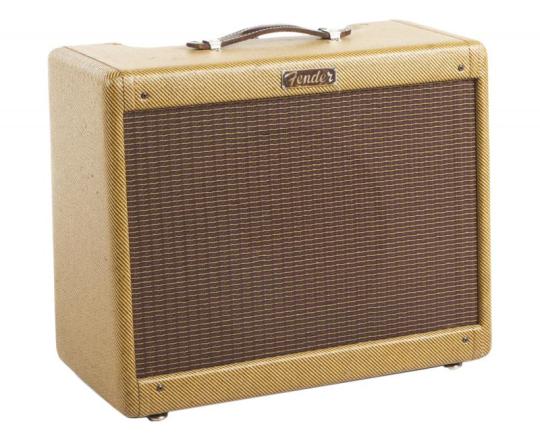
1955 Fender “Tweed” Champ ($2,000-$3,000)
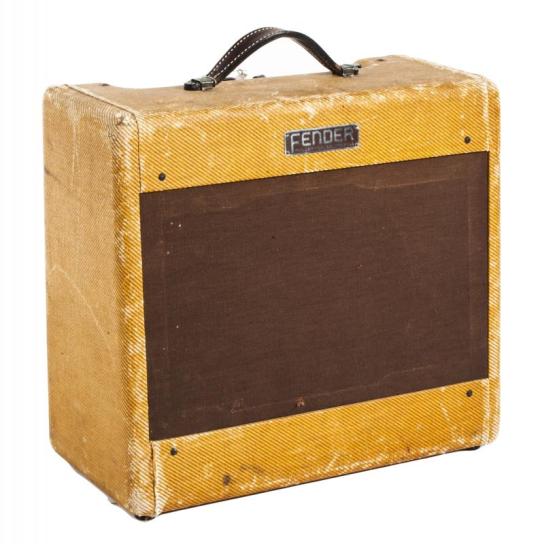
1954 Fender “Tweed” Champ ($2,000-$3,000)
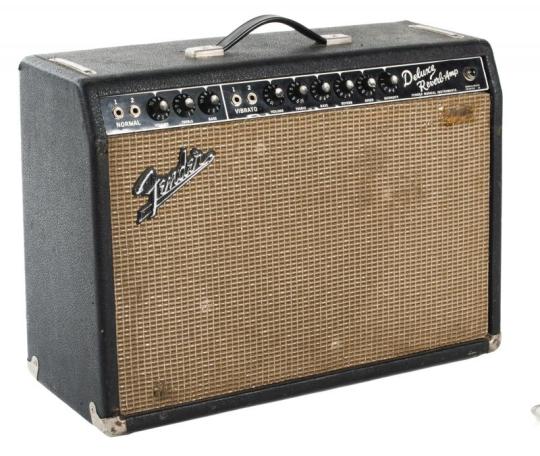
1965 Fender “Blackface” Deluxe Reverb ($1,000-$2,000)
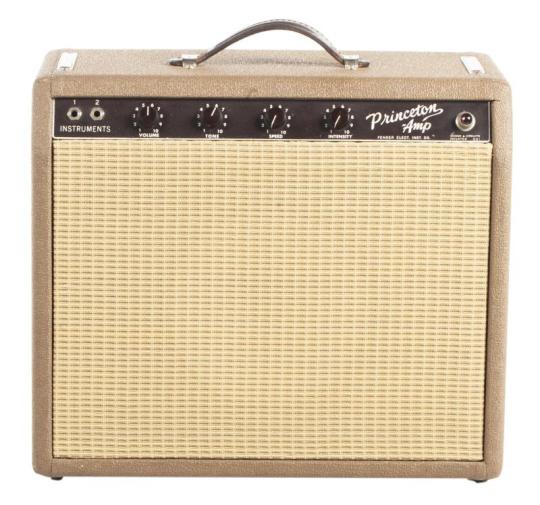
1962 Fender “Brownface” Princeton Reverb ($1,000-$2,000)
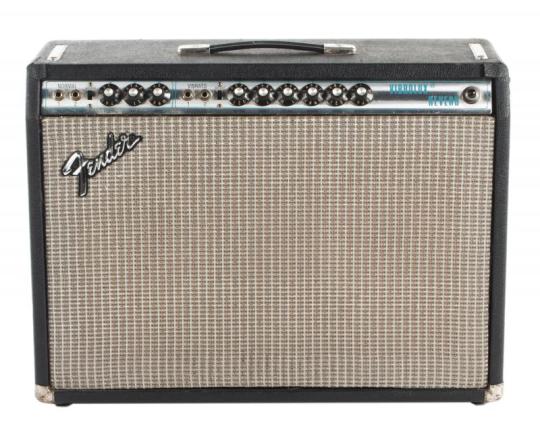
1974 Fender “Silverface” Vibrolux ($700-900)
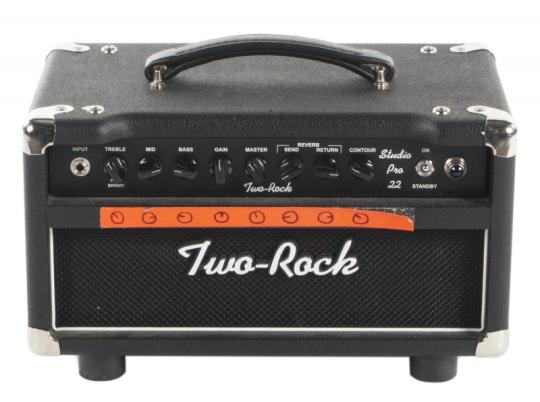
Two Rock Studio 22 ($1,000-$2,000)
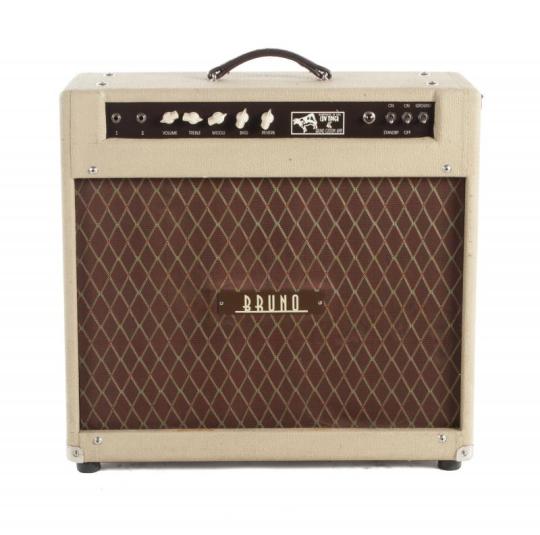
Bruno Cowtipper ($1,000-$2,000)

Matchless DC-30 ($2,000-$3,000)
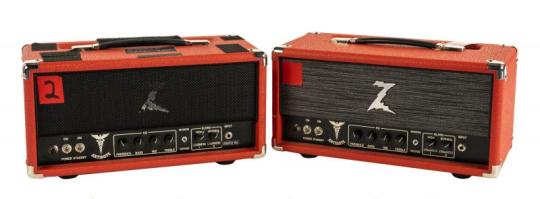
Dr. Z Antidote ($5,000-$7,000 for the pair)
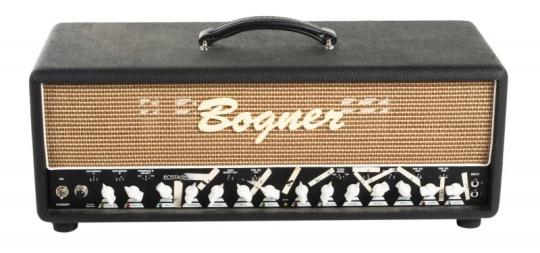
Bogner Ecstasy ($2,000-$3,000)
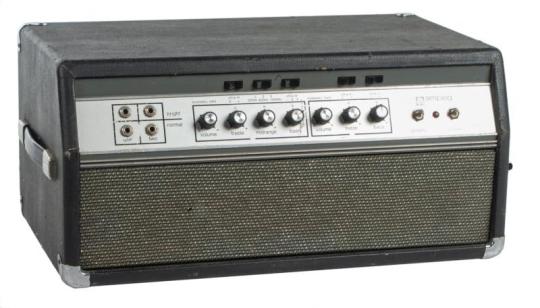
1972 Ampeg SVT ($1,000-$2,000)
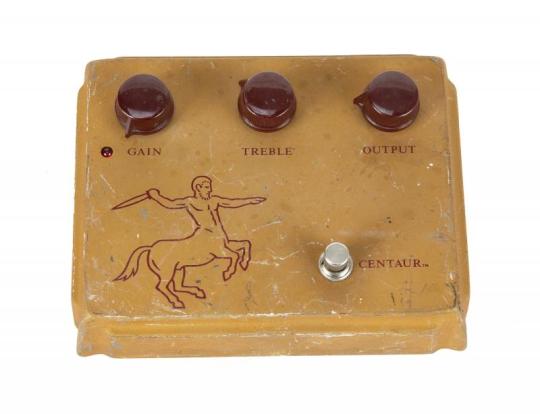
Klon Centaur ($1,500-$2,500)
NOTES: The reason there are so many small, low-wattage amps in Becker’s collection is because of their utility in the studio. When the tubes in amplifiers are working beyond their capacity, they produce pleasant-sounding harmonics. Obviously, in order to push the tubes into that overdrive, you need volume.
Volume isn’t an issue outdoors or in big clubs, but it’s not necessary in the small confines of a studio. In fact, if anything, you could argue that big amps are at a severe disadvantage in a studio. Think of Led Zeppelin’s first album and all those insane Jimmy Page guitar parts...all of that was recorded on a 5-watt Fender Champ with an 8″ speaker, cranked all the way up.
The Champs, the Deluxe Reverb, Vibrolux*, Princeton Reverb, Cowtipper, Two Rock and Matchless are low-wattage beasts that fit a certain role. The Champs gave you that classic dirt, the Princeton and Vibrolux a more refined version of that dirt. Deluxe’s were used for great cleans that were thisclose to being overdriven. The Matchless is what you used instead of a Vox. The Two Rock was a tiny Dumble. The Cowtipper was a Fender/Vox twist with a Marshall edge.
*If you bought a new Fender Vibrolux exactly like Walter Becker’s, you would pay more than the estimated winning bid. Which makes zero sense, given that amp probably has some fat, amp nerd genius’ fat greasy fingerprints all over it.
The Dr. Z and Bogner amps are for the live rig. The Bogner Ecstasy is probably the most beautiful sounding high-gain amplifier in the world, and the Dr. Z was probably bought because he wanted to buy something. Dr. Z’s are made in Cleveland tho, so of course I had to include that amp somehow. Speaking of higher-wattage amps...remember that anecdote I told you about “Reelin’ in the Years” guitar part being recorded on a cranked Ampeg SVT? That’s likely it.
Which brings us to the Klon...obviously not an amp. The Klon is still used by top guitarists everywhere because it adds something very subtle, but majorly impactful to your sound. Forgetting the mythos, it has three things that will forever be in utility...it’s completely transparent, it’s buffered, and it sounds amazing.
It’s a transparent treble boost pedal. Now, all pedals, channels, cables, etc color your sound somewhat. If every company made truly transparent stuff, it’d all sound the same. But say you have your tone (clean or distorted)...and you want to boost your tone with no color...that’s where the Klon comes in.
The buffered line? On long cable chains, your signal gets weaker...buffered lines help maintain the integrity of that signal from guitar to the speaker. And when you add the extremely transparent treble boost to the signal, your tubes start to produce more harmonics without adding in any distortion or extra bass and mids that could woof the speaker. For top guitarists, something like that is incredibly useful...some even keep it on all the time.
***
That’s all.
0 notes
Text
Top 14 Best Guitar Fuzz Pedals & Octave Fuzz Pedals of 2019
What is Guitar Fuzz
Guitar Fuzz is a term which commonly describes a distortion effect produced on a guitar signal. The term fuzz is often used interchangeably with distortion and overdrive, however, we believe that there is a distinct difference between fuzz, overdrive and distortion, with guitar overdrive pedals and guitar distortion pedals providing a more overdriven, dirtier sounding distortion. However, none-the-less, the fuzz pedal still overdrives the preamp and as a result, provides a lovely warm analog-sounding fuzz.
Fuzz effects pedals have been created since the 1960s, in what was the common term ‘fuzzbox’ effects units.
What does a Guitar Fuzz Pedal do?
As previously touched on, a guitar fuzz processor will usually have an internal preamp and analog circuitry (unless it’s a digital pedal). Therefore, the fuzz sound is created when the gain dB is increased to a level in which the preamp begins to struggle to cope, hence it’s ‘overdriven’. This overdriven effect also adds sustain, harmonic and inharmonic overtones to the guitar signal, making it sound more compressed and adding an overall warmth and ‘fuzzy’ character to its tone.
What are the most popular types of Guitar Fuzz?
As with all effects, there are sub-categories and criteria to other related effects. An example of some popular types of fuzz unit is Octave Fuzz, sub-octave fuzz, variac fuzz, etc.
What is an Octave Fuzz Pedal?
Octave fuzz pedals are ones that not only provide fuzz on the input signal’s frequency, but they provide additional accompanying frequencies, 1 which is 12 semitones (1 octave) above and is referred to as an ‘upper octave fuzz’, and 1 which is 12 semitones (1 octave) below, which is referred to as a ‘sub-octave fuzz’. Fuzz is then applied to the accompanying signals, and there is usually a gain knob for the user to be able to raise or lower the intensity of this fuzz, independently of the main signal’s fuzz tone.
Well, that’s enough of us discussing the holistic workings of fuzz processors! Let’s actually discuss what the best fuzz pedals & fuzz octave pedals are in 2019.
Top Fuzz Pedals & Fuzz Octave Pedals
Behringer Super Fuzz SF300 Fuzz Pedal – $ – Buy on Amazon – Budget-Priced Recommendation
Donner Stylish Fuzz Pedal – $ – Buy on Amazon
Electro-Harmonix Octavix Octave Fuzz Pedal – $$ – Buy on Amazon
Electro-Harmonix Deluxe Big Muff Fuzz Pedal – $$$ – Buy on Amazon
MXR M236 Super Badass Variac Fuzz Effects Pedal – $$$ – Buy on Amazon
EarthQuaker Devices Octave Fuzz Blaster – $$$ – Buy on Amazon – Octave-Fuzz Recommendation
MXR SF01 Slash Octave Fuzz – $$$ – Buy on Amazon
MXR M225 Sub Machine EQ/Fuzz Pedal – $$$ – Buy on Amazon
EarthQuaker Devices Hoof V2 Hybrid Fuzz Pedal – $$$$ – Buy on Amazon
Catalinbread Octapussy Modern Octave Fuzz Guitar Effects Pedal – $$$$ – Buy on Amazon
Death by Audio Fuzz Effect Pedal – $$$$ – Buy on Amazon
Catalinbread Perseus Sub-Octave Fuzz Guitar Effects Pedal – $$$$ – Buy on Amazon
Wampler Velvet Fuzz V2 Guitar Effects Pedal – $$$$ – Buy on Amazon
JHS Muffuletta Fuzz Guitar Effects Pedal – $$$$$ – Buy on Amazon – Premium-Priced Recommendation
Behringer Super Fuzz SF300 Fuzz Pedal – $
Budget-Priced Recommendation
Features
Fuzz pedal created by Behringer
Recreate those infamous 60s/70s fuzz tones
Extremely affordable
Metal Chassis
3 different sound modes for classic fuzz, grunge and gain boost
2-band EQ
Gain & overall level controls
Red LED when the effect is engaged
Designed & build in Germany
Product Warranty
Technical Specifications
Monophonic in/out
True bypass
Runs on 9v battery or 9v power-supply (included)
Weight: 0.33 kg
Dimensions: 2.8″ x 2.1″ x 4.8″
Customer Review Rating
The Behringer Super Fuzz SF300 has received an average rating of 4.1* out of 5 stars from 188 Amazon customer review – Read these reviews here
Summary
The Super Fuzz SF300 pedal by Behringer is an uber affordable guitar fuzz unit, capable of helping your recreate those famous tones of the 60s/70s era.
The fuzzbox itself has three different sound modes which include classic fuzz, grunge and gain boost.
Additionally, it has a 2-band EQ (bass and treble controls) and separate level and gain controls, so that you can really have plenty of options when it comes to perfecting your overall fuzz sound.
So how exactly does it sound?
As you can hear from the video demonstration, this pedal is extremely versatile, even considering its affordable price.
Classic fuzz mode provides that accentuated mid-range, and alongside the range of EQ options, it’s really versatile in shaping anything from a lower background fuzz, to an in-your-face fuzz.
Grunge fuzz mode provides a more full-bodied fuzz sound, with scooped mids and some sharper upper harmonics, typical of 90’s and onwards grunge and heavy rock. The gain control really allows for you to sharpen the overall fuzz, and engage the upper harmonics, even turning this pedal into more of a mid/heavy distortion.
The Gain boost really helps in pushing the overall guitar sound through the mix, and depending on your EQ settings, will simply accentuate those.
What would we improve?
Considering the incredibly cheap price, it would simply not be viable to make recommendations without it directly affecting the retail price.
Therefore, there’s nothing we can suggest needs improving!
Who is this pedal for?
Quite simply, this unit for the guitarist on a budget, looking for a decent quality guitar fuzz effects pedal, that despite the low-price, still gives you the ability to make adequate changes to both your fuzz sound and EQ.
Overall, a fantastic option for lower-budgets!
youtube
Donner Stylish Fuzz Pedal – $
Features
Guitar fuzz pedal by Donner
Incredibly affordable
Aluminium Alloy Chassis
LED indicator shows when its engaged
Includes volume, tone and ‘bustain’ (fuzz) controls
Technical Specifications
Monophonic in/out
True bypass
9v DC power supply (not included – Boss SYB-5 9v power adapter – Buy on Amazon)
Weight: 0.22 kg
Dimensions: 4.7″ x 2.5″ x 2.4″
Customer Review Rating
The Donner Guitar Stylish Fuzz pedal has received an average rating of 4.3* out of 5 stars from 165 Amazon customer review – Read these reviews here
Summary
The Stylish Fuzz pedal by Donner is an extremely compact, highly affordable fuzz pedal.
The unit itself is very simple to use, having a main ‘Bustain’ knob which controls the level of Fuzz applied to the signal. Additionally, it also has a tone and volume knob for further personalization of the output sound.
Since this pedal is so inexpensive, Donner don’t actually provide a power-supply, which we aren’t too keen about! However, it features a standard 9v DC power supply port, so you can pick one up for very cheap.
So how exactly does it sound?
As you can hear from the video demonstration, even when the fuzz effect is on its lowest setting, it still provides a noticeable amount of fuzz to the output signal.
The combination of fuzz and tonal controls mean that you can adjust the overall EQ of the output relatively easily. However, when comparing this directly with the similarly priced Behringer SF300, you cannot isolate the Bass and Treble frequencies like you can with the SF300, giving you slightly less overall control.
What would we improve?
Although this unit is marketed as a budget-solution, we think that all guitar effects pedals should at least come with a power supply.
However, as for the unit’s sound, you can expect a no-thrills fuzz.
Who is this pedal for?
This unit is definitely for the guitarist who’s looking for a cheap guitar fuzz pedal, but simply does not have the room for the Behringer SF300 (as we prefer the SF300).
The Donner Stylish Fuzz unit is a little smaller, so for those guitarists who may lack space on their pedalboard, this may be for you!
youtube
Electro-Harmonix Octavix Octave Fuzz Pedal – $$
Octave-Fuzz Recommendation
Features
Octave Fuzz Pedal by Electro-Harmonix
Classic 60’s style octaver fuzz
Switchable voltage changes the overall sound
9v: saggy sounding fuzz
24v: tighter sound fuzz
LED lights when the unit is engaged
Volume, Boost and Octave fuzz controls
Designed and built in New York, USA
Technical Specifications
Monophonic in/out
True bypass
Runs on 9v battery & 9v power supply (included)
Switchable 9 & 24 v power rails
Weight: 0.49kg
Dimensions: 6.25″ x 3.2″ x 5.65″
Customer Review Rating
The Electro-Harmonix Octavix octave fuzz pedal has received an average rating of 4.6* out of 5 stars from 17 Amazon customer review – Read these reviews here
Summary
The Electro-Harmonix Octavix is an octave fuzz pedal for guitar, and helps recreate that late-60’s sounding octave ‘fuzzbox’ effect. The unit itself is a throwback to the original ‘Octavia’, and incorporates the same sound and vibe of that fuzzbox.
The effect of the original Octavia fuzzbox designed by Roger Mayer (Jimi Hendrix’s sound technician) was first heard in such records as ‘Purple Haze’ in 1967, by Jimi Hendrix, and from then on was replicated by other guitar/pedal manufacturers to try to emulate this sound.
As for the Octavix fuzz unit by Electro-Harmonix, it has three main control knobs, which adjust the octave effect, volume and level of boost (fuzz).
Additionally, there is a toggle switch on the unit which allows the user to choose between utilizing the pedal at 9v and 24v. At 9v the fuzz effect sounds looser, whilst at 24v, the fuzz sounds tighter and provides more emphasis on the upper-frequency range.
So how exactly does it sound?
As you can hear from the video demonstration, this pedal is definitely a fuzz pedal through and through! With the addition of the voltage toggle switch and interface controls, it’s extremely versatile in providing different fuzz tones, whilst still providing an analog, 60’s sounding warmth like the original Octavia pedal did.
What would we improve?
Quite simply, because this pedal is a throwback to the original Octavia pedal created for Jimi Hendrix, it’s a unique unit and cannot be compared to other octave fuzz processors within this list.
Who is this pedal for?
If you’re a fan of Purple Haze, Jimi Hendrix and that classic 60’s sounding octave fuzz tone, then you’ll probably be a fan of this unit. Additionally, considering the price of the pedal, you’re getting a lot for your money.
youtube
Electro-Harmonix Deluxe Big Muff Fuzz Pedal – $$$
Features
Big Muff Pi Deluxe Fuzz Pedal by Electro-Harmonix
Delivers all of the classic sounds of the NYC Big Muff Pi & more
Includes several interface controls
volume, tone, sustain, attack, gate, EQ, filtering
Includes two footswitches
Includes expression pedal input
2 LEDs for processor engagement
Owners manual
Technical Specifications
Dual input (signal & expression pedal)
Monophonic output
True bypass
Runs on 9v battery and 9v power adapter
Weight: 0.88 kg
Dimensions: 3.5″ x 7″ x 8″
Customer Review Rating
The Electro-Harmonix Deluxe Big Muff Fuzz Processor has received an average rating of 4.3* out of 5 stars from 26 Amazon customer review – Read these reviews here
Summary
The Electro-Harmonix Deluxe Big Muff pedal is the ultimate fuzz pedal, being able to capture the sounds of all of the previous Electro-Harmonix ‘Big Muff’ pedals that have been released, making it incredibly versatile and an attractive unit for those guitarists who just want one unit to replicate the entire ‘big-muff’ product range.
Not only this, but since the Deluxe Big Muff pedal has added attack, EQ and gating settings, it provides further capacity to personalize the overall output.
We could spend all day discussing in-depth about the range of psychedelic, synth-like and full on fuzz sounds that you can achieve by using this unit, but what’s better is that we’ve provided a video demonstration of all of these effects below.
So how exactly does it sound?
As you can hear from the video demonstration, the deluxe big muff pedal really can provide a variety of fuzz sounds, with the addition of bass boosts, synth-like qualities, gating and EQ settings.
What would we improve?
Quite simply, there’s nothing to improve!
Who is this pedal for?
The Big Muff Deluxe pedal is for the guitarist who’s a fan of the Electro-Harmonix Big Muff series, and potentially wants the option to be able to replicate any of the previous big muff pedals, all through using one single processor.
Additionally, for those who aren’t fanatics (yet), this unit will simply provide so many fuzz tones, giving your guitar sound a fresh breath of life.
youtube
MXR M236 Super Badass Variac Fuzz Effects Pedal – $$$
Features
Fuzz processing pedal by MXR (Jim Dunlop)
Vintage silicon circuit which has been modified
Ability to change operating voltage 5v-15v
Increased voltage for more headroom & clarity
4 interface knobs including tone, variac, output and gain
Technical Specifications
Monophonic in/out
True bypass
Runs on 9v battery & 9v power supply (not included – Boss SYB-5 9v power adapter – Buy on Amazon)
Weight: 0.32 kgs
Dimensions: 5.5″ x 4.5″ x 3″
Customer Review Rating
The MXR M236 Super Badass Variac Fuzz Pedal has received an average rating of 4.1* out of 5 stars from 10 Amazon customer review – Read these reviews here
Summary
The M236 Super Badass Variac Fuzz Pedal by MXR is a unique unit, especially for a mainstream company such as MXR (Jim Dunlop). We say this because it has some very unique features that other pedal’s simply don’t have… Such as the ability to manually adjust voltage input, and the unit’s rare vintage silicon circuit, modified for modern use.
However, let’s talk more about the unit’s voltage ‘Variac’ switch, which provides the ability to change the input voltage from 5v to 15v. At 5v the unit provides a much more scooped sound, especially around the upper-frequency spectrum; A style that would suit some heavier rock, and grunge music (Soundgarden comes to mind).
At 15v, the upper frequencies are really apparent within the mix, and the sound is full, bright and up in your face.
Due to the way in which the variac knob is, you can input any voltage between 5v-15v, so that you can really find the perfect balance for your style of playing.
So how exactly does it sound?
As you can hear from the video demonstration, it’s an extremely versatile unit, and the variac, tone, gain and output controls really give you full access to making both dynamic changes and tonal changes to the sound.
What would we improve?
We really like this unit, and the fact that MXR has been brave enough to be innovative, reminding us of a new, innovative start-up company…We hope that MXR keeps up with these kinds of developments. Well done Jim Dunlop/MXR!
Who is this pedal for?
This fuzz pedal is definitely for the guitarist who wants total control of their fuzz sound, from the tonality, output, gain and voltage levels… It’s truly a fantastic unit, and the high review ratings on Amazon also confirm this!
youtube
EarthQuaker Devices Octave Fuzz Blaster – $$$
Plenty of ‘Clipping Style’ options, and ring modulation sounds
Features
Guitar Octave Unit manufactured by EarthQuaker Devices
Handmade in Akron, Ohio (USA)
Octave Fuzz Processor
Mono Input & Output
Interface controls include:
Tone: Adjust the filtering & signal tonality from dark to bright
Level: Control the output dB level
Fuzz: Control the level of ‘Fuzz’ within the output signal
Voice: 3-way toggle switch controlling the ‘clipping style’
Mode 1: Germanium Clipping – Produces a looser sounding fuzz tone
Mode 2: Silicon Clipping – Produces a tighter, more compressed sounding tone
Mode 3: Open, Pure Transistor Drive – Produces a clean octave-up effect, and creates a modulation effect, similar to ring modulation. [Source]
True Bypass (Footswitch): Engages/Disengages Pedal
Runs a 9V Power Supply (Not Included – Linked to below)
LED lights when the pedal is engaged
True Bypass
Owners Manual
Technical Specifications
1 x 1/4″ jack input
1 x 1/4″ jack output
A 9V Power adapter is needed for operation. This is sold separately (Boss SYB-5 9v power adapter – Buy on Amazon)
Weight : 1.13kg
Dimensions : 4.75″ x 2.50″ x 2.25″ inches
Customer Review Rating
The EarthQuaker Devices Fuzz Master & Octave unit has received an average rating of 4.5* out of 5 stars from 44 Amazon customer review – Read these reviews here
Summary
The Fuzz Master General Octave Blaster, created by EarthQuaker devices certainly is an interesting pedal.
Similarly to other fuzz/octave pedals, this unit is adequately sized, optimal for fitting on most pedal boards, and is simple to use, given that it has 3 main control knobs, 1 toggle switch and a footpedal featured on the interface.
The control knobs Tone, Level & Fuzz control the majority of the unit’s functionality, and you can achieve a wide range of fuzz/distortion and octave sounds with these alone. However, the pedal gets particularly interesting when you take a look at the 3 different voicing modes that are accessible with the toggle switch. These essentially control the ‘clipping style’ that is picked, changing the way the internal circuitry deals with the overloading fuzz gain, and giving the overall sound a completely different tone. From the more open sounding ‘Germanium Clipping’ to the much tighter sounding ‘Silicon Clipping’, it leaves you more options!
So how exactly does it sound?
As you can hear from the video demonstration featured below, the Fuzz Master General can sound particularly ‘out of control’ for lack of a better term… Particularly when used in the Germanium Clipping voice mode, and when the fuzz is turned up.
However, a nice element to its sound is the slight ring modulation sound that you can get, which is perfect from those deeper, low neck riffs.
Alternatively, if you’re a soloing guitarist, you’ll find that cranking the Fuzz knob to 10, and engaging the unit will provide you with more than enough ‘tone’ to begin to annoy even your drummer! (As we all know, the loudest member of the band… Until now!)
What would we improve?
We don’t have much to say as far as improvements go! This is a handmade, boutique unit and therefore its hard to compare it against other batch-production units.
The stomp button is quite stiff, but some would say that’s a good thing so you’re not pressing it accidentally. Alternatively, we wouldn’t say that the Fuzz effect is particularly suitable for softer styles of music, including Blues… It’s more ideal for rock and more aggressive guitar styles.
Who is this pedal for?
If you’re a guitarist who wants a octave/fuzz unit with a range of ‘clipping style’ modes at hand, and you also want to have access to some other cool overdrive sounds and ring modulations, then this may be for you!
As always, before you decide, take a look at the video demonstration of the EarthQuaker Fuzz Master unit in action.
youtube
MXR SF01 Slash Octave Fuzz – $$$
The
Features
Guitar Octave Unit manufactured by MXR (Jim Dunlop)
Combines searing fuzz effects with octave harmonies
All analog circuitry
Aged-appearance solid metal casing for protection
Mono Input & Output
Interface controls include:
Volume: Control the output dB level
Tone: Adjust the filtering & signal tonality
Fuzz: Control the level of ‘Fuzz’ within the output signal
Sub Octave: Control the level of the sub-octave signal in the mix
Octave Up: Control the level of upper octave signal in the mix
True Bypass (Footswitch): Engages/Disengages Pedal
Runs on a 9V Battery (Included) and/or a 9V Power Supply (Not Included – Linked to below)
LED lights when the pedal is engaged
True Bypass
Owners Manual
Technical Specifications
1 x 1/4″ jack input
1 x 1/4″ jack output
A 9V battery (Included) and/or a 9V Power adapter is needed for operation. This is sold separately (Boss SYB-5 9v power adapter – Buy on Amazon)
Weight : 1.13kg
Dimensions : 3.0″ x 5.0″ x 4.0″ inches
Customer Review Rating
The MXR SF01 Slash Octave/Fuzz unit has received an average rating of 5.0* out of 5 stars from 11 Amazon customer review – Read these reviews here
Summary
The SF01 is a guitar octave and fuzz unit, developed by MXR (Jim Dunlop) in collaboration with signature guitarist Slash.
The processor itself is encased in a sufficiently sized, slightly eroded-looking metal casing, which has 5 interface control knobs and two footswitches for complete functionality. The control knobs include Volume, Tone, Fuzz, Sub Octave and Octave Up, all of which control the dB levels of the dry, octave and fuzz signal.
Since this thing has been co-created by legendary guitarist slash, you can guarantee that you get his signature sound, which is that overdriven, fuzz sounding distortion which also cuts through on low-end frequencies too… This can all be achieved with the SF01, with the aid of the on-board fuzz effects and sub-octave.
Additionally, for those searing guitar solos, the use of the upper-octave ‘octave up’ control means that you’ll have no trouble cutting through the mix and having your solo heard when playing alongside other band-members.
All-in-all, it’s certainly a pedal for the slash guitarist enthusiasts!
So how exactly does it sound?
As you can hear from the video demonstration featured below, and as we’ve described, this unit really does open up the doors for helping achieve that well-known slash-like, searing analog guitar tones that we all know and love.
From immensely overdriven, searing solos, to rumbling sub-octave guitar riffs, this unit makes it possible.
What would we improve?
This unit is definitely in what you would describe as a ‘blue ocean’, with it being a signature guitar pedal developed by such a legendary guitarist, we simply cannot compare it to other units (from a functional or sonical perspective) within the list.
In our opinion, this unit sounds awesome, and the 5* Amazon rating/reviews also suggest that there really isn’t anything that needs improving.
Who is this pedal for?
We can say with full confidence that if you’re in any way looking to achieve a tone similar to one that Slash would be happy with, this unit will satisfy your needs!
It’s versatile in it’s application, in regards to the ability to turn down the fuzz effects and play on a cleaner channel, but we both know, that’s not why you would want to get this pedal!
However, before you decide, take a look at the video demonstration of the MXR SF01 unit in action.
youtube
MXR M225 Sub Machine EQ/Fuzz Pedal – $$$
Features
Sub Octave Fuzz Pedal by MXR (Jim Dunlop)
100% analog circuitry
Versatile fuzz options
4 main controls for volume, tonality, fuzz level and sub-octave level
Two footswitches
One for fuzz processor engagement
One for sub-octave engagement
Technical Specifications
Monophonic in/out
True bypass
Weight: 0.86 kg
Dimensions: 5.5″ x 4.5″ x 2.5″
Customer Review Rating
The MXR M225 Sub Machine Fuzz Octave Pedal has received an average rating of 5 out of 5 stars from 5 Amazon customer review – Read these reviews here
Summary
The M225 Sub Machine Fuzz by MXR is a vintage sounding Fuzz-Octave processor which has a range of fuzz and octave tones to suit most styles of playing.
It has 4 main control knobs, which include volume, tone, fuzz and sub-octave… And then 2 footswitches to separately engage/disengage both the fuzz effect and the sub-octave effect, so they can be used individually or simultaneously.
The volume control helps in changing the overall signal dynamics, whilst the tonality acts as a filter scoop, helping brighten up the high-end frequencies as it’s turned clockwise.
So how exactly does it sound?
As you can hear from the video demonstration, even when the fuzz is turned to its lowest setting, it’s still extremely noticeable within the overall mix. We really like the overall tonality to this pedal, with the fuzz sounding a little more synth-like and warm.
However, we advise that you take a listen and make up your own mind!
What would we improve?
We really like that MXR has thought carefully about the design of this unit, providing the ability to isolate both the octave and fuzz engagement.
Therefore, we think it’s a great unit and there isn’t much we can suggest in regards to improvements.
Who is this pedal for?
We think this unit is for the guitarist who wants a sub-octave fuzz unit, which is capable of providing high-quality fuzz and octave effects. Not only this, but all within a decent price range, especially considering it’s created by MXR.
youtube
EarthQuaker Devices Hoof V2 Fuzz Processing Pedal – $$$$
Features
Fuzz pedal built by EarthQuaker Devices
The Hoof is loosely based on the classic Sovtek green Russian muff-style circuit
Features a hybrid Germanium/Silicon design
Can provide anything from a slight to extreme fuzz sound
Handmade in Akron, OH USA
Owners Manual
Technical Specifications
Monophonic in/out
True bypass
Weight: 0.29 kg
Dimensions: 6″ x 3″ x 3″
Customer Review Rating
The EarthQuaker Devices Hoof V2 Pedal has received an average rating of 4.5* out of 5 stars from 44 Amazon customer review – Read these reviews here
Summary
The Hoof V2 by EarthQuaker Devices is the 2nd edition in the Hoof series, being an upgrade from the original Hoof fuzz pedal.
The pedal boasts a hybrid germanium/silicon circuit which is based on the classic Sovtek green Russian muff-style circuit, helping give it quite a unique sound.
Not only this, but all of these pedals are individually constructed, by hand, all in Akron, OH in the United States, so you can expect a high-quality sound and aesthetic finish.
So how exactly does it sound?
As you can hear from the video demonstration, the Hoof V2 can go from producing a very dirty, mid-heavy sounding fuzz through to a much cleaner fuzz with more transparent upper frequencies.
What would we improve?
Considering all of these units are handcrafted, and have been built from extremely high spec materials… There’s nothing we can suggest that needs improving.
Who is this pedal for?
This pedal is for the guitarist who wants to own a more bespoke, boutique-sounding pedal, with high-quality components which have been put together by hand.
youtube
Catalinbread Octapussy Modern Octave Fuzz Guitar Effects Pedal – $$$$
Features
Fuzz stompbox created by Catalinbread
Incredibly unique aesthetic design
Boutique-looking pedal
Easy to use with 3 main knobs, attn, gain & body
Can run on 9v or 18v
Fuzz circuitry responds well to pitch & playing dynamic
Owners manual
Technical Specifications
Monophonic in/out
LED bypass
Voltage: 9v or 18
Weight: 0.23 kg
Dimensions: 5″ x 3″ x 3″
Customer Review Rating
The Catalinbread Octapussy has received an average rating of 4.5* out of 5 stars from 3 Amazon customer review – Read these reviews here
Summary
The Octapussy fuzz stompbox by Catalinbread certainly is one of the most eye-catching effects units that we’ve seen in a long time. The orange base colour with purple, lilac and pale blue decals really make it rather attractive, and a pedal that any guitarist will be asking to hear about.
As for the actual functionality and technical specifications of the pedal, it’s quite straight-forward to use, with it having 3 main control knobs which include, Attenuation, Gain and Body.
Additionally, one of the most attractive elements of the Octapussy is the engineering that’s gone into creating this stompbox. The main engineer Howard Gee from Catalinbread created a simple circuit, to try to alleviate complexity which often results in an overcompressed output signal. Therefore, by doing this, the Octapussy has a great dynamic range and is sensitive to different playing styles.
So how exactly does it sound?
As you can hear from the video demonstration, the octapussy really provides a nice tonal fuzz sound to your guitar sound, and you can hear from the way the guitarist plays in the video, that the pedal does a great job in customizing the tone to the guitarist’s style of play.
Additionally, the guitarist in the video demonstration makes a great point, in saying that the Octopussy is a fantastic octofuzz unit, as it makes you play differently than you would without it, highlighting the fact that it exhibits excitement and is a catalyst for creativity and ingenuity.
What would we improve?
As with any kind of improvement suggestions, you look at other pedals and evaluate other features that are better, and could be adopted by this unit. However, since this is more of a boutique pedal, it’s very hard to do this.
Who is this pedal for?
This pedal is great for any guitarist who firstly has the budget, and secondly wants a boutique-looking and dynamic sounding pedal that will simply make you excited about playing with it. It’s extremely similar to the famous Octavia fuzz unit, but provides a clearer, more pronounced fuzz tone.
youtube
Death by Audio Fuzz Effect Pedal – $$$$
Features
Guitar Fuzz stompbox by ‘Death By Audio’
Industrial looking aesthetic design
Simple to use with 3 control knobs
Creates anything from deep fuzz tones to screaming highs
45-day warranty
Handmade in NYC, USA
Technical Specifications
Monophonic in/out
True Bypass
Weight: 0.54 kg
Dimensions: 10″ x 7″ x 6″
Customer Review Rating
The Fuzz War by Death By Audio has received an average rating of 4.3* out of 5 stars from 10 Amazon customer review – Read these reviews here
Summary
The Fuzz War pedal by Death By Audio is certainly one of the most unique fuzz processors that we’ve featured within the list… From it’s more industrial metal housed casing, through to the smudged print typography on the front of the pedal itself.
It has three main knobs, which control the level of fuzz, tonality and the overall output volume.
So how exactly does it sound?
As you can hear from the video demonstration, this fuzz unit sounds wild!
What would we improve?
This is very much a pedal for a niche audience, and because of this, it doesn’t necessarily conform to normal standards… Therefore, we simply don’t have any improvement suggestions.
Who is this pedal for?
For the guitarist who’s going through a mid-life crisis, and just needs a release! We’re joking!
We definitely think this would be ideal for a guitarist who’s after a bespoke looking, heavily distorted fuzz pedal, potentially suited for heavy rock or grunge.
youtube
Catalinbread Perseus Sub-Octave Fuzz Guitar Effects Pedal – $$$$
Features
Sub-octave fuzz pedal by Catalinbread
Volume, cut and blend controls
Switch between 1 or 2 octaves down
Plenty of output volume
Mix fuzz and octave effects with blend control
Easy to use interface
Owners manual
Technical Specifications
Monophonic in/out
True bypass
Voltage: 9v
Weight: 0.22 kg
Dimensions: 5″ x 3″ x 3″
Customer Review Rating
The Catalinbread Perseus OctaveFuzz has received an average rating of 4.5* out of 5 stars from 3 Amazon customer review – Read these reviews here
Summary
The Perseus Sub-Octave Fuzzbox is another fuzz unit by Caralinbread that we’ve featured within this list. This pedal offers different sound processing in comparison to the ‘octapussy’, with the Perseus pedal catering for guitarists looking for a sub-octave fuzz.
Although you can use this as an octavefuzz, the interface options allow you to isolate the fuzz effect, so you don’t necessarily have to engage the sub-octave effects simultaneously. Additionally, the blend knob can be used to find the right balance of octave and fuzz for the output signal.
The unit has a built-in gate, so once you stop playing, it’s completely silent! Which may be an aspect that you find appealing.
So how exactly does it sound?
As you can hear from the video demonstration, the pedal really delivers in providing a high-quality lower octave accompaniment, which even stretches to 2 octaves below the input signal.
What would we improve?
Although guitarists have the ability to completely isolate the fuzz effect, so no sub-octave can be heard. The ability to do this for the sub-octave, so that no fuzz can be heard is simply not available. This is potentially an aspect we would like to see on this unit.
Who is this pedal for?
For those guitarists who want a boutique-style fuzz octave pedal, with versatility and plenty of tone, the Catalinbread Perseus unit may be for you!
youtube
Wampler Velvet Fuzz V2 Guitar Effects Pedal – $$$$
Features
Fuzz stompbox unit by Wampler Pedals
A number of interface options, including fuzz level, volume, EQ and filtering
Features 2 different clipping options
Designed & Built in the USA
Owners manual
Technical Specifications
Monophonic in/out
True bypass
Power: 9v battery or 9v power adapter
Weight:
Dimension: 6″ x 4″ x 4″
Customer Review Rating
The has received an average rating of 4.1* out of 5 stars from 39 Amazon customer review – Read these reviews here
Summary
The Wampler Velvet Fuzz is one of the more expensive fuzz pedals that we’ve featured on the list. With that being said, it includes plenty of interface options which allow you to personalize your overall fuzz sound, from brightness settings to ‘big’ and ‘tight’ modes, which both provide different kinds of overtones.
The pedal can be powered from its internal 9v battery, and from a 9v power adapter, so that you have the freedom to use it with or without a plug socket nearby.
So how exactly does it sound?
As you can hear from the video demonstration, it provides a really nice, controlled, some might say refined, fuzz tone. We particularly like the overall sound of the fuzz, as it doesn’t distort the overall guitar signal overly, maintaining note clarity, even on the low notes down near the neck-end of the fretboard.
What would we improve?
Some reviews of this pedal indicate that the unit sounds very digitalized, and whilst this might be a negative for some, it may also be attractive for others.
Who is this pedal for?
If you have the budget, and are looking for a refined fuzz tone, this is perfect! We imagine that it would be best suited for a guitarist who wants a cross between a nice sounding fuzz and a mild distortion/overdrive, which can achieve some wonderfully sounding harmonic overtones.
youtube
JHS Muffuletta Fuzz Guitar Effects Pedal – $$$$$
Premium-Priced Recommendation
Features
Fuzz Guitar Processor by JHS Pedals
Most premium-priced unit on the list
Features 5 well-known, all-analog big-muff fuzz tones
The civil war
The russian
The pi
The triangle
’73 rams head
JHS 2015
Additional interface controls including volume, sustain and tone
All JHS pedals come with a 2-year unconditional warranty
Owners manual
Technical Specifications
Monophonic in/out
True bypass
Weight: 0.27 kg
Dimensions: 6″ x 3″ x 3″
Customer Review Rating
The JHS Muffuletta fuzz pedal has received an average rating of 4.3* out of 5 stars from 36 Amazon customer review – Read these reviews here
Summary
The Muffuletta Fuzz Pedal by JHS was definitely a pleasant surprise for us here at Sustain Punch. Our first impression of the unit itself is that it provides such a wonderfully full-sounding fuzz distortion (especially on the JHS 2015 circuity setting), but that’s just the tip of the iceberg.
Underneath the hood, this unit provides 5 fuzz circuit tones, all of which can be accessed via the interface’s ‘tone’ knob. Additionally, it also has a ‘Volume’, ‘Sustain’ (Level of Distortion) and ‘Tone’ (Equalization) knob, so that you can really modify these factory settings until your ear is content.
Now, this is the most expensive unit featured on the list, granted! However, one aspect that we particularly like about this pedal is the fact that it comes with a 2-year unconditional warranty! So you can rest assured that it this thing’s working for years to come.
So how exactly does it sound?
As you can hear from the video demonstration, the JHS Muffuletta has such a versatile range of sounds! This is due to the 5 analog modes that are available:
The civil war – Increased mid-range and high-end articulation
The russian – Aggressive, compressed with major fuzz
The pi – More aggressive, edgy-sounding fuzz
The triangle – More articulate, with additional low-end response
’73 rams head – Scooped mids, less gain and a dark texture
JHS 2015 – Less compressed fuzz with a lovely rich tone
Overall, this is an incredibly versatile unit!
What would we improve?
Although it’s a little pricey, the fantastic fuzz tones and 2-year warranty make up for this!
Who is this pedal for?
This little pedal is definitely for the serious guitarist who has a large budget. Therefore if you really value tone, this may be an attractive option for you.
youtube
In Conclusion, which fuzz pedal would we recommend?
Well, as always with our recommendations, we rarely approach this section lightly, and we realize that every one of our readers has different requirements, budgets, etc.
Therefore, we’ve made our recommendations accordingly, so that there’s truly a fuzz pedal suitable for each and every one of our readers:
Behringer Super Fuzz SF300 Fuzz Pedal – $ – Buy on Amazon – Budget-Priced Recommendation
EarthQuaker Devices Octave Fuzz Blaster – $$$ – Buy on Amazon – Octave-Fuzz Recommendation
JHS Muffuletta Fuzz Guitar Effects Pedal – $$$$$ – Buy on Amazon – Premium-Priced Recommendation
The post Top 14 Best Guitar Fuzz Pedals & Octave Fuzz Pedals of 2019 appeared first on Sustain Punch.
source https://www.sustainpunch.com/guitar-fuzz-pedals/
0 notes
Text
5 Tips For Hooking Your Street Car … On or Off the Track!
Crafty racers like Mike Goodman can somehow get a street car to hook up on gravel. We asked, and he was willing to share his hard-won knowledge on how he gets his gorgeous ’69 Nova SS to make consistently fast passes, lap after lap.
In the entire history of mankind, we doubt there has ever been a true drag racer who has taken his new car to the track for the first time and said, “That’s fast enough.”
We figure you fall into that category too, so we asked longtime racer Mike Goodman to share some of his tips for traversing the quarter mile just a bit quicker. Goodman’s bright blue ’69 Nova SS is famous in street racing circles. It’s definitely the definition of a true street machine. Besides the hood, the body is all original steel, and the roof is even still clad in an old-school vinyl top.
Like all veteran racers, Goodman understands getting down the track faster than the next guy requires more than simply having the most horsepower. He knows all the tricks for getting a car to hook, no matter the conditions. As proof, Goodman won the Midnight Drags at the 2017 Car Craft Super Nationals, and this year when the organizers were looking to beef up the big-tire class, he volunteered to run his small-tire Nova against the big-rubber behemoths and nearly won again. He finished second (see the video and coverage here (Midnight Drags Presented By Gear Vendors Overdrive: Saturday Results & Gallery!), losing in the final round to Bryant Goldstone’s world-beating ’73 AMC Javelin.
Anybody who can take a 3,500 pound all-steel car and run against all comers has our respect. Plus, he was incredibly forthcoming when we asked him to share the hard-won knowledge that allows him to consistently make 8.0-second passes time after time. “It’s all pretty simple,” he explains, “after you’ve spent 20 years beating your head against a wall trying to figure it out.”
Plan Ahead
First things first: Goodman understands that money is an issue for everybody, and if you waste it you are already behind the curve.
“Plan for where you want to be and work to that goal intelligently,” he explains. “Buy good parts that are going to get you to that goal.
“If you don’t know what your goal is, or if you are too cheap to buy the right stuff the first time, you end up buying the same parts over and over. And that costs you more money in the long run.”
There’s nothing secret or unobtainable in the powerplant underneath Goodman’s hood. It’s a 565 cubic-inch, carbureted big-block, and there’s no missing the nitrous system he uses to pour on the power.
To be able to do that well, it means you’ve got to have good communication with your engine builder and chassis fabricator. And if you do those things yourself, you’ve got to be up on your game. Goodman stresses that simple systems can be fast. For example, in an age where turbos are dominating, he continues to race and win with a nitrous-fed 565 cubic-inch big-block.
Places to consider are your fuel supply system, your air intake, and your exhaust. All can quickly become bottlenecks as you add horsepower to help you get down the track more quickly.
Tire Choice
One mistake Goodman says he often sees less experienced racers make with a street car is to choose a very aggressive race tire with too little sidewall strength. A street car is typically significantly heavier than a full-blown race car, and they require more sidewall support in the tire. This is especially true if you are racing on an unprepped surface.
Goodman’s Nova is an all-steel car and weighs in around 3,500 pounds. He says heavier street cars require rear tires with a stronger sidewall and more air pressure to help support the car. Start out with 11 pounds of pressure or so and do a series of 60-foot hits. Keep lowering the air pressure until the car starts to shake and wobble, and then increase the tire pressure back to your previous mark.
When a DOT tire is required with his 3,500 pound Nova, Goodman says he prefers the Mickey Thompson ET Street stiff sidewall. The next test is to figure out just how much air pressure in the rear tires the car needs. You can do this by making a series of 60-foot test runs to see how the car hooks up. Begin with plenty of pressure in the tires—maybe 10.5 to 11 psi—and then work your way down. You will know when the air pressure is too low because the car will start to shake and wobble, forcing you to pedal the throttle on the starts. Move back up to the lowest air pressure that still felt good and continue on with your setup prep.
With a full-weight car, another option is to run a tube or beadlocks on the rear wheels. This helps keep the tire from distorting on hard hits.
Nitrous vs Turbo
Even though nitrous is his weapon of choice, Goodman calls turbos “the ultimate power-adder.” You can make tons of power with nitrous, which is why it has become so popular lately.
“You can make more power with a turbo, but they can also be difficult to work with on the starting line,” he explains. “You’ve got to have time to get the turbos spooled up, and if you don’t have everything right, you can overpower the tires.
It doesn’t matter how much power you have on tap, it’s no good if you can’t control how it gets to the tires. Goodman keeps his Edelbrock progressive nitrous controller within easy reach on the dash to help tune how it comes on so that he can apply the most power possible without smoking the tires.
“That’s where you can sometimes find an advantage with nitrous. You’ve got to have the suspension and tires right, but with nitrous you can leave faster and harder. If you are in a race with a starter using an arm drop, they may not give you enough time to spool the turbos up before the drop. My nitrous is on a micro-switch. I can stage quicker, and when the tree goes green or the arm drops, I’m gone.
“Whether you go turbo, or nitrous, or all motor, they all have their advantages. You’ve just got to determine what will work best for you.”
Be Adjustable
Goodman says that with the power available these days, it’s almost mandatory if you hope to be consistently fast—especially if you race different tracks or tire compounds—that you use double-adjustable shocks. He estimates that tuning is 80 percent of the game. A double-adjustable shock can make your life significantly easier because it makes meaningful suspension changes as simple as turning one or two knobs.
Normally, a double-adjustable shock will have two dials somewhere on the body of the shock. One will control shock compression and the other rebound. They are more expensive than a standard, non-adjustable shock, but with a good double-adjustable you will only need one set. And while you are investing in a quality set of double-adjustables, you can also set your car up with coilovers which makes ride-height adjustments and corner-weight adjustments a breeze.
Goodman uses double-adjustable coilover shocks on all four corners of the car, and he says they are especially important on the rear end. If you switch from bias-ply tires to drag radials, he says the required settings are just about opposite. Making those changes are a lot easier when you can simply turn a couple knobs to reset the shocks’ compression and rebound.
“If you run different classes or tracks and find yourself running bias-ply tires one weekend and drag radials the next, double-adjustable shocks are a must.” Goodman explains, “That’s because the best setups for the different tires are almost directly opposite each other. Instead of making a bunch of changes, with double-adjustable shocks you can just make your changes right on the shocks.”
Front Travel
Don’t think front wheel travel is important when it comes to setting up your car? Here’s a clue to how important Goodman thinks it is:
“If we’re at the track and I find out you don’t know what your front travel is, I don’t need to know anything else. I want to race you for money!”
Front travel is drag racing lingo that can more accurately be described as front droop. We don’t care about the total wheel travel, just how much the front wheels can move down as the front end of the car rises up from ride height until the tire leaves the asphalt.
Front travel is a critical setting for maximizing traction because it influences weight transfer. The more traction a track has, the less front travel you need. Here, in front of the coilover shock you can see the travel limiter Goodman uses to dial in exactly how much front travel he needs.
You can measure front travel by setting the car up at ride height (don’t forget to either have the driver in the seat or simulate his weight with sand bags). Take a measurement from the top of the wheel opening, or somewhere else on the front of the car, then place a jack under the front crossmember and slowly raise the car. Stop when the front wheels just leave the ground and take your measurement again. That’s your front wheel travel.
On the track, front travel is important because it plays a huge role in weight transfer. Street cars don’t have the same flex as tube-chassis Pro Mods or other cars, so it is important to get the front end to lift up to move weight over the rear tires so you gain traction. As a rule, the looser the track (less traction), the more you want the front end to rise. And more front travel equals more lift on the front end.
Goodman recommends having at least five inches of front travel. His Nova actually has 5.5 inches to work with. Just like with tire pressure, he will start with lots of front travel and then tighten it up as necessary. Many manufacturers make limiting straps that can be used to control front travel on street cars. You don’t want any more front travel than necessary because lifting the front of the car takes power. If the track is tight with plenty of traction, you can limit front travel so that the front of the car doesn’t lift as much and more of the engine’s horsepower can be used to move the car down the track. It’s all a balancing act.
Weight Matters
Speaking of weight transfer, Goodman says controlling it is critical for getting down the track consistently. We’ve already talked about how you can use front travel to tune weight transfer, but it is also important to get as much weight out of the car as possible. Next, whatever weight you can’t get off the car, move as much as you can to the back.
At 3,500 pounds, Goodman’s Nova is not exactly a lightweight, so it’s not imperative to have the absolute lightest car on the track. With a street car it can be tough to get weight off the front and over the rear axle, but do what you can. Goodman says he races with his Nova at a 51/49 front/rear weight split, and that works pretty well for him.
Generally, you don’t want to have to carry any more weight down the track than you have to, but sometimes you must add weight to the rear to get the traction you need. An easy way to do this is by simply adding fuel. This is why Goodman has installed a 15-gallon fuel cell in his Nova. The capacity is way more than he will ever need for a quarter-mile pass, but it’s the easiest way in the world to add weight to the rear of the car. Plus, since this is a real street car, the extra range is nice when Goodman takes his Nova on the road.
One easy way to add weight if necessary is with fuel. Even though he will never need it all for a quarter-mile pass, Goodman has installed a 15 gallon fuel cell because it is an easy and quick way to increase the rear weight percentage if necessary. Race fuel weighs between 6 and 7 pounds per gallon, so if you find yourself needing a bit more traction, throwing in an extra few gallons of fuel can get you there with only a minimal weight penalty.
Control Issues
“These days, as easy as it is to make power, anybody can go buy enough horsepower to blow the tires off of anything,” Goodman says. “If you are going to win races, you’ve got to be able to control the application of power so you can get down the track without spinning the tires.”
Goodman is talking about more than just a sensitive right foot. There are boost controllers for turbocharged and supercharged engines, multi-stage nitrous controllers for nitrous engines, and even timing controllers for any type of engine. There’s a lot more science in making the most of these systems than we have room for here, but the key is to invest in a system and spend the time and effort required to make the most of it.
And most of all, Goodman says going fast is all about balance. Consistency comes down to finding the right balance that gives you the traction you need to get out of the hole without smoking the tires–and then use all the available horsepower to get down the track.
The post 5 Tips For Hooking Your Street Car … On or Off the Track! appeared first on Hot Rod Network.
from Hot Rod Network https://www.hotrod.com/articles/5-tips-hooking-street-car-off-track/ via IFTTT
0 notes
Text
Bass Multi-Effects Pedals | 10 Best Multi Effects Pedals for Bass (2018 Review)
In this article, we’re going to be talking about the top … Bass Multi-Effects Pedals that you can get for your bass rig.
However, before we do this, we’re going to first talk about what exactly a bass effects pedal does, and the main advantages and disadvantages over using singular function pedals such as a bass fuzz pedal or bass chorus pedal.
What is a Bass Multi-Effects Pedal?
Simply put, a Bass Multi-Effects Processor combines a multitude of bass effects within a single physical unit, making it particularly convenient for a bassist as they do not need to purchase an entire pedal board, wiring kits and individual effects pedals.
Usually, these units come with the standard effects which include compression/limiter, EQ, distortion, overdrive, delay, reverb, tuner, chorus and a few more.
What are the main advantages and disadvantages of using a Multi-Effects Pedal for Bass?
As previously mentioned, the main advantage of using a multi-effects pedal is…
The convenience of having all the effects in a single unit;
Additionally, they are generally significantly lower in cost than if you were to purchase all of the equivalent singular pedals that would provide the same functionality.
As for the disadvantages, we’re a little hesitant to discuss these, as they’re less applicable in this case, as we’re only sharing the 10 best bass multi-effects pedals, and hence these disadvantages don’t necessarily apply to these.
However, we’re here to talk objectively and thus we’ll explore the subject, and the main disadvantage is that some multi-effects units lack the superior sound quality of the singular units; Most of the time this is for two main reasons;
The singular effect pedals usually have analogue circuitry, giving it a more natural, warmer sound… Most multi-effects units use digital circuitry, although we have featured a few analog pedals.
There are fewer sounds available in a singular effects pedal, thus the development teams can focus on these select few and effect these much easier than if there were 100s.
Therefore it’s simply a choice as to, do the benefits outweigh the drawbacks… If so, then read on where we’ll be discussing the 10 top bass multi effects pedals. Otherwise, take a look at our range of singular function effect pedals reviews.
Well, let’s get to it!
What are the top Bass Multi Effects Pedals?
Boss ME-50B Bass Multi-Effects – $319.99 – Buy on Amazon
Zoom B1on Bass Multi-Effects Pedal – $79.99 – Buy on Amazon
VOX STOMPLAB2B Multi-Effects Modeling Pedal for Bass Guitar – $89.99 – Buy on Amazon
Zoom MS-60B Multi-Stomp Bass Pedal – $99.99 – Buy on Amazon
BOSS GT-1B Bass Effects Processor – $199.99 – Buy on Amazon
Zoom B3 Bass Guitar Effects & Amp Simulator – $199.99 – Buy on Amazon
Tech 21 Bass Fly Rig Bass Multi-effects Pedal – $294.03 – Buy on Amazon
Zoom B3n Multi-Effects Processor for Bassists – $199.98 – Buy on Amazon
Valeton Dapper Bass Guitar Multi Effects Pedal (VES-2) – $199.99 – Buy on Amazon
DigiTech BP90 Bass Guitar Multi-Effects Processor – $99.95 – Buy on Amazon
Boss ME-50B Bass Multi-Effects – $319.99
Features
Multi-Effects unit built specifically for Bass
Engineered by Boss/Roland
Utilizes Composite Object Sound Modelling (COSM) Technology developed by Roland
The unit has been a top seller for years
23 programmable memory banks
A large range of interface controls (23 different effects)
Compressor/Limiter
Filter/Tone
Drive/Synth
Delay/Modulation
Pedal Mode SW
Master
3 Foot Switches to control Filter/Tone, Drive/Synth & Delay/Modulation
1 Expression pedal
Built-in Tuner
Runs on 6 x AA batteries, but can also be directly run on a 9v power supply (not included)
Link to Owners Manual – Boss ME-50B Owners Manual
Technical Specifications
1/4″ jack input
2 x 1/4″ jack output (L + R Stereo Output)
9v battery (included): 9v AC adaptor is sold separately (9V Power Supply – Buy on Amazon)
Weight: 8.25lbs
Dimensions : 18″ x 12.5″ x 5.6″ inches
Summary
The Boss ME-50B is the golden standard of Bass Multi-Effects Processors. The unit itself has been around since 2004 and remain to this day a best-selling product; This is because it has so many fantastic characteristics which are worthy of praise.
Firstly, this unit has an extremely solid construction making it ideal for the gigging bassist bringing this on the road. Alongside this, the processor has 23 user programmable memory banks, with each bank being able to store 3 sounds per stomp pedal; That’s sound customization sorted.
Additionally, the 3 stompboxes can be engaged individually or simultaneously to create custom sounds, meaning the possibilities are endless (or near to being).
A nice thing about this processor is that it gives the user the choice as to run it on a 9V power supply (which is not included) or battery power (6 x AA batteries); So if the venue only has a few plug sockets available, that’s not a problem for you!
As for the slight drawbacks surrounding this product; Well it’s nearly 14 years old, but we can safely say considering it’s still a best seller that the sound quality has stood the test of time.
Other than this, it’s still a little pricey, being over $300. However, considering the sheer amount of functionality, this is a small price to pay in the long-run.
Who would we recommend this unit for
For those gigging bassists who want a highly reliable multi-effects pedal for bass, which will and has stood the test of time. It clearly has a multitude of features and sounds good.
For a demonstration of the processor, take a look at the video demonstration below:
youtube
Zoom B1on Bass Multi-Effects Pedal – $79.99
Features
Multi-Effects unit built specifically for Bass
Engineered by Zoom
100 bass DSP effects including Compressors, Noise Gates, EQ, Filters, Boosters, Overdrives, Pitch Shifts, Octaver, Chorus, Looper, Synth etc
100 user programmable patches
Up to 5 effects can be used simultaneously
Built-in Tuner
68 Built-in rhythm accompaniment patterns
Pedal/Tube Amp Model Simulations (Marshall Super Bass, Ampeg SVT, etc)
Aux input & headphone input
Runs on a 4 x AA batteries, but can also be directly run on a 9v power supply (not included) or via USB connection.
Link to Owners Manual – Zoom B1on Owners Manual
Technical Specifications
1/4″ jack input
1/4″ jack output
9v battery (included): 9v AC adaptor is sold separately (9V Power Supply – Buy on Amazon)
Weight: 1.41lbs
Dimensions : 6.1″ x 9.3″ x 2.0″ inches
Summary
The Zoom B1on Bass Multi-Effects Pedal certainly provides fantastic bang-for-your-buck! This unit is ideal for the bassist who’s after a lightweight, highly portable bass processor, which also has a huge range of features & functionality.
With over 100 effects to choose from, alongside 100 memory banks for the storage of user-created patches, it’s really able to provide you with a lot of customization in such a small unit.
Alongside the wide range of effects, it even features a Chromatic Tuner, Looper feature (30 seconds of CD-quality recording), accompanying rhythmic patterns (which can be used with the looper) and famous pedal/amp simulations;
This includes the unit being able to emulate such pedals as the MXR DynaComp, dbx 160A, Moog MF-101, etc… And such classic tube amplifiers as the Marshall Super Bass, Fender Bassman, Ampeg SVT, etc.
For the full range of pedal/amp model emulations visit Zoom’s page here: link to emulations
With over 100 available DSP bass effects, and with the option to use up to 5 effects simultaneously, it’s really a great unit… And all below $80! It’s a true steal.
As for the way in which the Zoom B1ob sounds, we like this processor, it has such a wide range of sounds to offer. The quality is good too, but remember this is around $80 and not $800, you’re not going to get your socks completely blown off. However, you will feel a tingling!
Who would we recommend this unit for
This pedal is suited to the casual bass player, someone who does the occasional gig, but is really looking to use this (with the use of rhythm patterns that can be played to) to facilitate your creativity, helping you write those incredible bass riffs.
For a demonstration of the processor, take a look at the video demonstration below:
youtube
VOX StompLab 2B Multi-Effects Modeling Pedal for Bass Guitar – $89.99
Features
Multi-Effects unit built specifically for Bass
Engineered by Vox
The processor is housed in a rugged metal casing
100 presets
61 programmable effects
10 amplifier options
Each preset can stack up to 8 simultaneous effects
Has built-in tuner & headphone amp
Runs on a 4 x AA batteries, but can also be directly run on a 9v power supply (not included)
Link to Owners Manual – Vox Stomplab2b owners manual
Technical Specifications
1/4″ jack input
1/4″ jack output
9v battery (included): 9v AC adaptor is sold separately (9V Power Supply – Buy on Amazon)
Weight: 4.5lbs
Dimensions : 9.0″ x 3.0″ x 7.0″ inches
Summary
The StompLab 2b is Vox’s answer to a bass multi-effects unit, aimed at providing a large range of effects and amplification simulators, whilst still being affordable to the everyday musician. The unit itself is priced in the same range as the Zoom B1on, and they are very close in their feature-set and functionality.
Some great selling points of the Vox StompLab 2b would be the strong, rugged metal casing that is beneficial to ensure longevity, alongside the fact that it’s built by one of the most renowned music equipment manufacturers in the world, so you should be confident in assuming it’s made up of high-quality components and has been tested meticulously.
As for the way in which the Vox Stomplab 2B sounds, well this really depends on how you plan to use it, for example, the clean effects, alongside wah and slap-bass settings sound awesome; However, some of the more overdriven effects can sound a little overwhelming.
Who would we recommend this unit for
This pedal is suited to the more casual bass player, but can definitely be used to play shows with it being built to last. The sounds that this processor can create are good, as long as you know there are limits to it’s capability, which were apparent on distortion/overdrive settings.
For a demonstration of the processor, take a look at the video demonstration below:
youtube
Zoom MS-60B Multi-Stomp Bass Pedal – $99.99
Features
Multi-Effects unit built specifically for Bass
Engineered by Zoom
Compact unit with metal casing, suitable for portability (gigs)
Backlit LCD screen for visibility
58 DSP effects & Bass Amplifier/Cab simulation models
Dynamics/Filter:
Overdrive/Distortion:
Amplifiers: 6 amp model emulations including Ampeg SVT, Fender Bassman, Hartke HA3500, ect
Modulation/Special Effects: 14 modulation & special effects (phasing, flanging, chorusing, detuing, pitch shift, tremolo
Delay/Reverb: 8 reverb types
For a full list of MS-60B effects visit the owners manual
Create, save and easily re-arrange effects in 50 memory patches
30 preset patches
Use up to 4 effects simultaneously
Tap tempo for sync of delay/modulation
Stereo output
Built-in Tuner
Runs on a 2 x AA batteries, but can also be directly run on a 9v power supply (not included) or via USB connection.
Technical Specifications
1/4″ jack input
2 x 1/4″ jack (stereo) output
9v battery (included): 9v AC adaptor is sold separately (9V Power Supply – Buy on Amazon)
Weight: 1.1lbs
Dimensions : 3.1″ x 3.8″ x 6.5″ inches
Summary
The MS-60B by Zoom is the second unit by the brand to feature on our list of top bass multi-effects processors.
This unit is highly compact and has a rugged metal casing, making it extremely suitable for the gigging musician. Not only this, but similarly to the Zoom B1on it offers a range of effects (although not as many), programmable patches and amplifier emulations.
The main difference between this pedal and the Zoom B1on, other than the metal casing, is the stereo output. Therefore if having a bass multi-effects pedal with stereo output is important, this may be the one for you.
The MS-60B can be powered from 2 x AA batteries, which is the least number of batteries needed by any unit we’ve featured on this list.
As for the sound quality, it really does impress; A solid sound quality on most of the effects, and it really does provide some versatile sounds, from arpeggiated synths to swooping synths, to heavy metal distortion (which surprisingly sounds somewhat good).
Who would we recommend this unit for
Someone looking for a highly portable, small, ruggedly built multi-effects processor for bass, with stereo output. This pedal sounds great and has a bunch of functionality to play with.
For a demonstration of the processor, take a look at the video demonstration below:
youtube
BOSS GT-1B Bass Effects Processor – $199.99
Features
Multi-Effects unit built specifically for Bass
Engineered by Boss/Roland
Not a huge unit, meaning it will fit snugly into a gig bag
Utilizes Boss’s most advanced sound engine + MDP
24-bit converters
90 bass effects
Compressor, Limiter, EQ, Overdrive, Distortion, Octave, Harmonist, Defretter, Bass Synth, Wah, Delay, Reverb, Phase Looping (32 seconds), etc
99 user-programmable presets + 99 (preset)
13 different Pre-amp types
Runs on 4 x AA batteries, but can also be directly run on a 9v power supply (not included)
Link to Owners Manual – Boss GT-1B owners manual
Technical Specifications
1/4″ jack input
2 x 1/4″ jack (stereo) output
Aux input
Phones Output
9v battery (included): 9v AC adaptor is sold separately (9V Power Supply – Buy on Amazon)
Weight: 0.65lbs
Dimensions : 4.5″ x 2.5″ x 5.5″ inches
Summary
The Boss GT-1B is marketed as Boss’ more premium-priced multi-effects bass unit. Looking closely at the range of functionality, alongside the technology behind the processor itself, it’s no wonder why it’s priced within this range.
The processor itself uses MDP (Multi-Dimensional Processing) Technology, which means that the input signal is segmented into many different elements based on the following criteria, pitch, loudness and timbre. By segmenting the signal based on these variables, the GT-1B is able to apply effect processing in a more detailed, refined way; Giving it a much better sound. For more information on MDP visit here.
You have access to 90 bass effects, and 99 user programmable presets; Presets can be downloaded and updated via the USB connection, and there is an on-board easy-edit mode for quick changes.
As for the sound quality of this unit… Yeah we really like this one! It honestly sounds great; Just take a listen to the first demonstration video.
My personal favourite effect was the most unlikely one called ‘Atmostphere’, which you can hear in the second video demonstration at 2.38.
Who would we recommend this unit for
We’d recommend this to a professional bassist looking for a long-term unit, for on-stage use and in-studio usage.
For a demonstration of the processor, take a look at the video demonstration below:
youtube
youtube
Zoom B3 Bass Guitar Effects & Amp Simulator – $199.99
Features
Multi-Effects Processor built specifically for Bass
Engineered by Zoom
Not a large unit
3 Backlit LCD screen for visibility
111 DSP effects & Bass Amplifier/Cab simulation models
Effects include Limiter, Graphic EQ, Para EQ, Attack, Wah, Filtering, Booster, Overdrive, Distortion, etc.
Emulating pedals such as Electro-Harmonix Big Muff, Fuzz Face, MXR Bass D.I.+, Fender Bassman, Hartke HA3500, Ampeg SVT, etc.
For a full list of Zoom B3 effects visit the owners manual and look under ‘Effect Types and Parameters’
Create, save and easily re-arrange effects in 100 memory patches
50 factory preset patches
Use up to 3 effects simultaneously
12 amplifier/cabinet modes
Looper: 40 seconds of looping
41 rhythm patterns to be used in conjunction with the looper
Built-in Tuner
Runs on a 4 x AA batteries, but can also be directly run on a 9v power supply (not included) or via USB connection
Technical Specifications
1/4″ jack input
1/4″ jack output
Balanced XLR Output (with ground lift for DI connection – pre of post effect)
Input for external foot-switch or expression pedal
USB port for power & updates
9v battery (included): 9v AC adaptor is sold separately (9V Power Supply – Buy on Amazon)
Weight: 0.65lbs
Dimensions : 4.5″ x 2.5″ x 5.5″ inches
Summary
As you can see, we clearly love Zoom… Well, we like them very much because they make really great processors, and the Zoom B3 is no exception.
This unit comes with 111 bass effects, alongside 100 memory locations where you as the user can store your own user-created patches. Additionally, this unit provides a range of amplifer/cabinet emulations which will keep you up until the early hours of the morning.
A unique feature about the Zoom B3 is the three LCD screens on the front of the interface, making it especially useful for someone looking to quickly change between more than 2 patches within a song/performance. These three LCD screens correlate with the 3 footswitches, which have multiple uses when held, providing quick access to the tuner and looper.
This more than makes up for the lack of an expression pedal, although there is a input for an external expression pedal for those who want one.
As for the sound quality of this unit, it sounds decent, especially for cleaner sounds. It does feature some effects which simply should not be used in any kind of commercial music, but the majority sound solid.
However, unless you really need the DI output, take a look at the B3n which we review further down in this article; Since the B3n is the newer model.
Who would we recommend this unit for
This is ideal for the bassist who wants a huge array of effects which can be modified through using the DAW interface; The advantage of this processor is simply having three footswitches, which would make quick patch changes very easy.
For a demonstration of the processor, take a look at the video demonstration below:
youtube
Tech 21 Bass Fly Rig Bass Multi-effects Pedal – $294.03
Features
Multi-Effects Processor built specifically for bass
Engineered by Tech 21
Analog SansAmp technology
Rugged metal casing to protect the processor
No LCD screens, but LED lights for effect engagement
Multiple bass effects
Three band EQ, Octafilter, Chorus, Compressor, Boost, Tuner
Multiple footswitches
Runs on a 9V battery, but can also be directly run on a 9v power supply (not included)
Link to Owners Manual – Tech 21 Bass Fly Rig owners manual
Technical Specifications
1/4″ jack input
1/4″ jack output
XLR (DI) Output with ground connect
9v battery (included): 9v AC adaptor is sold separately (9V Power Supply – Buy on Amazon)
Weight: 0.65lbs
Dimensions : 12.5″ x 2.5″ x 1.25″ inches
Summary
The Tech 21 Bass Fly Rig is an old school looking processor; With it’s metal casing, LED lights and multiple metal stompboxes, it really gives off a vintage vibe.
The processor itself utilizes an all-analog SansAmp which helps capture a rich, underlying warmth and natural tone that is associated with the most sought-after tube amps.
With this technology being the foundation of how this unit works in creating that warm analog sound, it really does well at providing overdriven & fuzz-like sounds.
So how does this sound overall? It really does sound good, and the SansAmp analog technology really makes a noticable difference on the sound of the more overdriven settings… It sounds great for slap-bass. Additionally, the chorus tones sound fantastic too!
The only major negative for us is the price of this unit, being nearly $300 it may be a little steep for some, but considering the sound quality, it’s great!
Who would we recommend this unit for
We highly recommend this to the bassist looking for that vintage, all-analog sounding pedal. Just take a listen to the video demonstration, you’ll understand what we mean.
For a demonstration of the processor, take a look at the video demonstration below:
5.45 is where they isolate the bass sound, so you can hear it with full clarity
youtube
Zoom B3n Multi-Effects Processor for Bassists – $199.98
Features
Multi-Effects Processor built specifically for Bass
Engineered by Zoom
3 Backlit LCD screen for visibility
67 DSP effects
19 Dynamic effects
15 Overdrive & Distortion effects
17 Modulation effects
11 Delay & reverb effects
For a full list of Zoom B3n effects visit the owners manual
Create, save and easily re-arrange effects in 100 memory patches
50 factory preset patches
Use up to 5 effects simultaneously
5 adjustable amplifier/cabinet modes (Ampeg SVT, Fender Bassman 100, SWR SM-400, Trace Elliot AH400SMX, Aguilar DB 750)
On-board Looper: 80 seconds of looping
41 rhythm patterns to be used in conjunction with the looper
Built-in Tuner
Runs on a 4 x AA batteries, but can also be directly run on a 9v power supply (not included) or via USB connection
Technical Specifications
1/4″ jack input
2 x 1/4″ jack (stereo) output
1/8″ Aux in
Input for external foot-switch or expression pedal
USB port for power & updates
9v battery (included): 9v AC adaptor is sold separately (9V Power Supply – Buy on Amazon)
Weight: 0.65lbs
Dimensions : 4.5″ x 2.5″ x 5.5″ inches
Summary
Yet again, another Zoom processor in this article… But that’s because they are really that good!
The B3n provides 3 LCD screens, and 3 multiple-use stomp-pedals similar to it’s predecessor, the Zoom B3, but has an updated chipset and greater processing power.
The real update is the fact that 5 effects can be used simultaneously in the B3n unit, unlike the B3 unit providing 3.
This unit comes with 67 bass effects, alongside 100 memory locations where you as the user can store your own user-created patches.
Directly comparing this against its predecessor, the Zoom B3, it does provide fewer bass effects (nearly half with the B3 unit offering 111), however, it’s about quality, not quantity… With new patches being released for the B3n, as the B3 has now been discontinued.
Additionally, this unit provides 5 adjustable amplifer/cabinet emulations so you really have a wide range of sounds that you can obtain.
However, despite the B3n unit being the updated model, it does not provide a DI output like the original B3 unit does.
As for the sound quality of this unit, it sounds decent, especially for cleaner sounds. It does feature some effects which simply should not be used in any kind of commercial music, but the majority sound solid.
Who would we recommend this unit for
This is ideal for the bassist who wants a huge array of effects which can be modified through using the DAW interface; The advantage of this processor is simply having three footswitches, which would make quick patch changes very easy.
For a demonstration of the processor, take a look at the video demonstration below:
youtube
Valeton Dapper Bass Guitar Multi Effects Pedal (VES-2) – $199.99
Features
Multi-Effects unit built specifically for Bass
Engineered by Valeton
Analog Technology
Similar size to the Tech 21 Bass Fly Rig
Rugged metal casing to protect the processor
No LCD screens, but LED lights for effect engagement
Multiple bass effects
Tuner, Boost, Compressor, Envelop Filter, EQ, Octave, Chorus, etc
Multiple footswitches
Runs on a 9V battery, but can also be directly run on a 9v power supply (not included)
Link to Owners Manual – Valeton Dapper Pedal owners manual
Technical Specifications
1/4″ jack input
1/4″ jack output
XLR DI Output
9v battery (included): 9v AC adaptor is sold separately (9V Power Supply – Buy on Amazon)
Weight: 0.65lbs
Dimensions : 4.5″ x 2.5″ x 5.5″ inches
Summary
The Dapper multi-effects pedal by Valeton is a thin unit, very similar in size, price and functionality to the Tech 21 Bass Fly Rig.
The unit consists of a metal outer casing, with analogue inner circuitry, helping give it a nice warm sounding output signal. The output signal can be routed through a 1/4″ inch jack and/or XLR output, making it great for live stage performances.
As for the sound quality… It sounds very nice, although we would prefer the Tech 21 unit over this processor, as this seemed to squash the overdriven sound a little too much for our liking. This unit is also particularly expensive.
Who would we recommend this unit for
Based on numerous factors, we would probably advise anyone interested in this unit to instead look at the Tech 21 Bass Fly Rig. However, take a look at the video demonstrations to come up with your own opinion.
For a demonstration of the processor, take a look at the video demonstration below:
youtube
DigiTech BP90 Bass Guitar Multi-Effects Processor – $99.95
Features
Multi-Effects unit built specifically for Bass
Engineered by Digitech
32 Bass effects
11 Amplifier models
5 Cabinet models
100 presets (50 factory & 50 user programmable)
40 drum patterns
Built-in Tuner
On-board Expression pedal
Requires power supply (Included)
Link to Owners Manual – Digitech BP90 owners manual
Technical Specifications
1/4″ jack input
2 x 1/4″ jack (stereo) output
Headphones (1/4″) output
Power Supply Included
Weight : 0.65lbs
Dimensions : 4.5″ x 2.5″ x 5.5″ inches
Summary
The Digitech BP90 is the brand’s bass multi-effects pedal. It comes at the high-end of what would be considered a lower-tier budget, and for this you do get a range of functionality, including plenty of bass effects, amplifier/cabinet emulations and presets to choose from.
As for where this processor sits in comparison to others around this price-point, it’s safe to say that we believe there are newer, more technologically advanced and better-sounding processors on the market; I.E the Zoom MS-60B.
However, please don’t take our word for it alone, check out the demonstration videos to get a full audible representation of how it sounds in comparison.
As for the sound quality, it’s really good considering the price. Some of the effects that stood out for us as being particularly good were the cleaner reverbs and chorus effects.
Who would we recommend this unit for
This would be great for the casual bassist looking for a pedal to practice and jam with. However, even despite how impressed we were about this device, we’d still highly recommend one of the pirce-equivant Zoom pedals.
For a demonstration of the processor, take a look at the video demonstration below:
youtube
In Conclusion, which bass multi-effects pedal would you recommend?
As with all our review recommendations, we like to make sure that we represent all of our readers, which means making appropiate recomendations taking into condsideration budget, features and performance. Hence we’ve provided the following:
For the professional musician looking for
The post Bass Multi-Effects Pedals | 10 Best Multi Effects Pedals for Bass (2018 Review) appeared first on Sustain Punch.
source https://www.sustainpunch.com/bass-multi-effects-pedals/
0 notes
Text
Bass Overdrive Pedals | 10 Best Overdrive Pedals for Bass (2018 Review)
What is a Bass Overdrive Pedal?
Before we get into exactly what a bass overdrive pedal is, and it’s function, it’s firstly important that we distinguish the difference between overdrive and distortion. These two effects are commonly mistaken and used interchangebly and so it’s important, for bassists/musicians that may be new to choosing bass effects, that they fully understand what they want.
Ok, so distortion is the process of sound alteration in terms of tone and timbre, against the natural ‘acoustic’ sound. In clearer terms, a distorted sound muddies the signal, usually adding more gain, giving it that aggressive growl.
Overdrive is an effect that aims to simulate the sound of an overdriven tube amplifier, which is a milder, warmer, more organic sounding distortion. An overdrive effect is more suitable if you’re after a cleaner sounding texture, as opposed to a really rough and ready distortion effect.
Bass overdrive pedals are portable effects units which emulate this overdriven pre-amp sound at the tap of a stomp-box, where traditionally, overdrive was created through increasing voltage gain on tube amplifiers.
These units are commonly used inline with other bass effects pedals including bass compressor pedals which help to maintain db output consistency and bass EQ pedals which are used to help reduce and boost certain output frequencies, based on the bassists needs and sonic requirements.
Bass overdrive stomp-boxes are used in both a live performance environment, and in a studio recording setting.
How does a bass overdrive pedal actually work?
As we previously touched upon, bass overdrive pedals are used to emulate the same overdriven sound that could be achieved on tube amps. These modern effects pedals try to replicate this effect by increasing the level of gain, at specific outputs. This is why bass overdrive becomes more prominent within the mix as the input signal is increased, and when the input signal is low, a negligible amount of overdrive can be heard.
Although bass overdrive stomp-boxes exist in both analog and digital forms. Analog bass pedals provide a more accurate overdriven effect, with the analog circuitry being a similar replication than digital circuitry.
Ok, so I hope that clears up some questions about the overdrive effect for bass…
Before we continue, as much as we would like to suggest one pedal for everyone, it’s simply not a one-fits-all solution; Thus please make sure you listen to the video demonstrations, as everyone has different sonic requirements from an effects pedal, and by listening to each one, it’s the best way of finally qualifying if it’s really for you.
Well let’s get to it!
What are the top bass overdrive pedals of 2018?
Behringer Bass Overdrive BOD400 – $24.99 – Buy on Amazon
TC Electronic MojoMojo Overdrive – $49.99 – Buy on Amazon
Ampeg Scrambler Bass Overdrive – $99.99 – Buy on Amazon
MXR M89 Bass Overdrive Unit – $129.99 – Buy on Amazon
Boss ODB-3 Bass Overdrive – $119.99 – Buy on Amazon
Xvive Bass Overdrive – $39.99 – Buy on Amazon
MXR EVH5150 Overdrive – $199.99 – Buy on Amazon
Wampler Tumnus Overdrive – $149.99 – Buy on Amazon
Rowin Dumbler LEF-315 – $29.99 – Buy on Amazon
Coolmusic C-OV01 Crunchy Overdrive – $29.99 – Buy on Amazon
Behringer Bass Overdrive BOD400 – $24.99
Features
Behringer bass overdrive unit with plastic outer casing
For tube-like overdrive, suitable for 5 & 6 string bass
A clear copy of the ‘Boss ODB-3’, with cheaper parts, aimed to be inexpensive at $24.99 compared to the ODB-3 at $119.99
LED to let you know if the pedal is active (on), or being bypassed (off).
5 knobs on the unit,
Level – Volume Control
High – Boost/Reduce high frequencies
Low -Boost/Reduce low frequencies
Gain – Overdrive
Blend – Amount of mixed ‘bypassed’ and overdriven bass sound for signal output
Versatile in the overdrive tones that you can hear
Runs on a 9V battery, but can also be directly run on 9v power supply (not included)
Technical Specifications
1/4″ jack input
9v battery (included) : 9v AC adaptor is sold separately (9V Power Supply – Buy on Amazon)
Weight : 0.73lbs
Dimensions : 2.8″ x 2.1″ x 4.8″ inches
Summary
The Behringer Bass Overdrive unit is certainly something, but who can be surprised with the fact it’s a product of german engineering!
At a price-point which really should not be able to provide an overdrive pedal, let alone the outer shell of the unit, Behringer hit a home run.
This unit has a mass of functionality for you bassists that yearn for ultimate control over your overdrive sound… With 5 knobs on the front of the interface giving you an unlimited amount of tone/timbre customization, it’s suitable for 5-string and 6-string basses.
For a demonstration of the processor, take a look at the video demonstration below:
youtube
TC Electronic MojoMojo Overdrive – $49.99
Features
Compact Overdrive pedal designed by TC Electronic
Suitable for both Bass & Electric Guitar
Provides True Bypass for zero signal deterioration
Has 5 interface switches
Drive – Adjust level of overdrive effect added to the mix, to either achieve that slightly rough sound, or muddy fattened overdriven sound.
Voice – Two different voicing styles to choose from:
Up position – Frequency response is true to the input signal
Down position – Low-end frequencies are naturally boosted
Level – Adjust the overall output signal db
Bass – Boost/Reduce low frequencies
Treble – Boost/Reduce mid & high frequencies
Technical Specifications
1/4″ jack input
Includes 9v battery, 9v AC adaptor is sold separately (9V Power Supply – Buy on Amazon)
Weight : 1.4lbs
Dimensions : 5.0″ x 3.0″ x 4.0″ inches
Summary
The TC Electronic MojoMojo overdrive pedal is suitable for both bass guitar and electric guitar. It was created to simulate a tube amplifier sound with plenty of headroom and clarity and is very versatile in it’s ability to add overdriven tonality without dirtying the sound too much.
The pedal has a number of different interface controls (5 in total), which all can be used to mould and create the overall sound that you want.
For a demonstration of the processor, take a look at the video demonstration below:
youtube
Ampeg Scrambler Bass Overdrive – $99.99
Features
Compact Bass overdrive pedal by Ampeg
All metal chassis so it’s ideal for the touring/gigging musician
Provides true-bypass for clarity of output signal
High quality Ampeg circuitry, renouned for its use in their BA combo amplifiers
High visibility smokey blue on/off switch
Features 4 main interface controls
Drive: Controls the level of Bass Scrambler overdriven effect which is applied
Blend: Amount of mix between input signal and overdriven signal for output
Treble: 17db Boost or 14db Cut of higher frequencies within the mix
Volume: Overall db output level
Technical Specifications
1/4″ jack input
Includes 9v battery, 9v AC adaptor is sold separately (9V Power Supply – Buy on Amazon)
Weight : 0.6lbs
Dimensions : 2.2″ x 2.6″ x 4.5″ inches
Summary
The Ampeg Scramber is a unique overdrive pedal; Specifically designed for bass guitar, the pedal features the same circuitry as the renounced Amped BA-Combo amps (v2). Because of the verbal feedback from that amplifier, they decided to use it within this effects unit.
This pedal has an all-metal chassis, and so it can take a few knocks, making it suitable for the road. And at the price of $99.99 it’s one of the mid-range overdrive effects units featured within this article.
For a demonstration of the processor, take a look at the video demonstration below:
youtube
MXR M89 Bass Overdrive Unit – $129.99
Features
Overdrive pedal for bass – created by Jim Dunlop
Unique analog overdrive circuitry specifically designed for bass
Provides true bypass
Features a high visibility LED for on/off use
Has 4 main controls on the interface
Clean: Used to blend the input signal with the overdriven signal
Volume: Controls the overall db of the output signal
Tone: Controls the tonality and ‘colour’ of the overdrive effect
Drive: Controls the amount of overdrive effect that is added
Technical Specifications
1/4″ jack input
Includes 9v battery, 9v AC adaptor is sold separately (9V Power Supply – Buy on Amazon)
Weight : 0.7lbs
Dimensions : 4.5″ x 5.5″ x 2.5″ inches
Summary
The MXR M89 is one of the best mid-range overdrive effects pedals that you can consider. Just by listening to the video demonstration below, you can hear the quality of this pedal.
The pedal can be run on 9v battery, and can be run on a 9v power supply. It has 4 main controls which really offer a lot of tonal variety… So you can rest assured that this pedal is the perfect choice for all of your bass overdrive needs.
For a demonstration of the processor, take a look at the video demonstration below:
youtube
Boss ODB-3 Bass Overdrive – $119.99
Features
Overdrive pedal specifically for Bass Guitars
Created by Boss ensuring high quality components
Two-band EQ to adjust the tonality of the low and high frequency response
4 main interface controls
Level: Adjust the level of overdrive added to the overall sound
EQ: Two-band for high & low frequency cut/boost
Balance: Used to blend between dry and overdriven signal for the output
Gain: Adjusts the level of gain added to the output signal
Check indicator light for visual confirmation when the pedal is in use
Technical Specifications
1/4″ jack input
Includes 9v battery, 9v AC adaptor is sold separately (9V Power Supply – Buy on Amazon)
Weight : 1.15lbs
Dimensions : 5.9″ x 3.7″ x 2.5″ inches
Summary
The Boss ODB-3 is truly the creme-de-la-creme pedal of the bass overdrive world. Considering the build quality and price-point, this is definitely suitable for musicians who need an effects unit that can not only provide a high quality, realistic overdrive effect, but also perform night after night, without fail.
The Behringer BOD400 is the cheaper alternative to the Boss ODB-3, being designed based on the ODB-3’s specifications, except at a cheaper price-point and subsequently a lower quality build… However, the Behringer BOD400 has glowing recommendations for anyone who doesnt want to fork out $119.99.
For a demonstration of the processor, take a look at the video demonstration below:
youtube
Xvive Bass Overdrive – $39.99
Features
Xvive overdrive pedal specifically designed for Bass
Compact pedal in durable metal chassis
On/Off LED for visual confirmation that the pedal is activated
True Bypass
Simple to use with three main interface controls
Volume: Adjust the level of output db
Compression: Adds more compression, limiting the dynamic range of the signal
Gain: Controls the intensity of overdrive effect
True Bypass
Sturdy On/Off switch, making it ideal for live performances, with no chance of turning it off without serious pressure.
Technical Specifications
1/4″ jack input
Requires a 9v AC adaptor is sold separately (9V Power Supply – Buy on Amazon)
Weight : 0.51lbs
Dimensions : 4.2″ x 2.4″ x 2.0″ inches
Summary
The Xvive overdrive pedal is one of the smaller, more inexpensive pedals that we’ve featured in the list. This particular pedal is ideal for the bassist who’s looking for a quick and simple to use overdrive processor, with the ability to add compression in the same unit.
A solidly built pedal, but it may lack some features such as 2-band EQ that other pedals within this price range are offering (i.e the Behringer BOD400). None-the-less, this is certainly a fantastic option!
For a demonstration of the processor, take a look at the video demonstration below:
youtube
MXR EVH5150 Overdrive – $199.99
Features
MXR EVH5150 for Bass Guitar and Electric Guitar.
Designed in collaboration with Eddie Van Halen
Premium quality for professional recording sound quality
True Bypass
Features hand-adjusted multistage MOSFETs
On/Off LED for visual confirmation that the pedal is activated
Multiple controls
Gate: Controls noise gate to minimise unwanted noise
Output: Adjust the level of output db
3-Band EQ
Bass: Boost/Reduce bass frequencies
Mid: Boost/Reduce mid-range frequencies
Treble:Boost/Reduce mid-range frequencies
Gain: Controls the intensity of overdrive effect
Boost: Adds more gain and compression to the output, really ramping up the overdrive
Technical Specifications
1/4″ jack input
Includes 9v battery, 9v AC adaptor is sold separately (9V Power Supply – Buy on Amazon)
Weight : 1.03lbs
Dimensions : 5.5″ x 4.5″ x 2.5″ inches
Summary
The MXR EVH5150 is an overdrive unit, designed and built in collaboration with the iconic Eddie Van Halen. The pedal is a result of high-quality engineering, having hand adjusted MOSFETs (metal oxides semiconductor field effect transistors) which help by changing the characteristics and performance of the analog circuity [Wikipedia].
At this price-point, the MXR EVH5150 is the most expensive unit that we’ve featured. And we think that this unit is aimed mostly at professional musicians who need an ultra high quality overdrive, and/or someone who has a high budget.
For a demonstration of the processor, take a look at the video demonstration below:
youtube
Wampler Tumnus Overdrive – $149.99
Features
Hand-built Overdrive pedal for Bass Guitar and Electric Guitar.
Built in the USA
Extremely compact, and will fit onto any pedal board
Buffered Bypass
High quality resistors and film capacitors, helping achieve a fantastic sound and frequency response
Extremely versatile in its sonic ability
Very simple to use, having a few interface controls
Gain: Controls the level of grit and overdrive
Treble: Adds more top end frequency to the output
Volume: Controls the db level
Technical Specifications
1/4″ jack input
Requires a 9v AC adaptor is sold separately (9V Power Supply – Buy on Amazon)
Weight : 1.00lbs
Dimensions : 1.5″ x 3.5″ x 1.5″ inches
Summary
The Wampler Tumnus overdrive pedal is an excellent choice for musicians with a higher budget; This USA handmade pedal is ideal for the bassist looking for a premium, high-quality, compact pedal that’s both simple to use and versatile in functionality.
Please note that it does require a 9V power supply to operate, providing any more voltage will melt the circuitry, so only use a 9V supply.
For a demonstration of the processor, take a look at the video demonstration below:
youtube
Rowin Dumbler LEF-315 – $29.99
Features
Vintage analog overdrive pedal for bass and electric guitar
Very compact unit with a sturdy metal casing
Fantastic for the price
True Bypass
Very simple to use, having few interface controls
Volume: Controls output db
Voice: Controls the colour of the overdrive effect
Tone: Adjust the tone of overdrive
Gain: Controls the level of overdrive
Technical Specifications
1/4″ jack input
Requires a 9v AC adaptor is sold separately (9V Power Supply – Buy on Amazon)
Weight : 0.48lbs
Dimensions : 3.7″ x 1.8″ x 1.9″ inches
Summary
The Rowin Dumbler LEF-315 unit is the ideal overdrive pedal for someone on a budget; The pedal itself is suitable for both bass guitar and electric guitar, and does a wonderful job at emulating the ‘custom modified Dumble amplifier’.
If one thing is for certain, for the price, you really cannot go wrong in having this on your pedalboard.
For a demonstration of the processor, take a look at the video demonstration below:
youtube
Coolmusic C-OV01 Crunchy Overdrive – $29.99
Features
Multifunctional overdrive unit for bass and guitar
Sleek black coloured aluminium alloy casing
Blue LEDs around footswitch and control knobs
Very compact unit with a sturdy metal casing
Fantastic price for both visual appearance and sound quality
Simple to use, having three main controls
Output: Controls output db
Tone: Adjust the tone of overdrive effect
Gain: Controls the level of overdrive
Technical Specifications
1/4″ jack input
Requires a 9v AC adaptor is sold separately (9V Power Supply – Buy on Amazon)
Weight : 0.48lbs
Dimensions : 3.7″ x 1.8″ x 1.9″ inches
Summary
On first impressions, we were particularly impressed with the Coolmusic Crunchy Overdrive pedal, with it’s sleek black outer shell with beautiful blue LED lighting around the footswitch and controls, it really is a thing of uttery beauty!
However, how does it sound? Well, it has some really cool and unique sounds, and is particularly versatile, being able to provide really crunchy overdrive, to a much smoother sound.
For the price-point, it’s a fantastic option!
For a demonstration of the processor, take a look at the video demonstration below:
youtube
Conclusion – The Winner is?
Best Low Cost Overdrive pedal – Behringer BOD400 (Buy on Amazon)
Best Premium Quality Overdrive pedal – Boss ODB-3 (Buy on Amazon) or Ampeg Scrambler (Buy on Amazon)
Best Portable Overdrive pedal – MXR M89 (Buy on Amazon)
Best Looking Overdrive pedal – Coolmusic C-OV01 Crunchy Overdrive (Buy on Amazon)
We highly advise that you take a listen to all of the video demonstrations before making your final decision, this way you can see which one resonates with your personal taste.
However, based on our recommendations, we hope you agree!
The post Bass Overdrive Pedals | 10 Best Overdrive Pedals for Bass (2018 Review) appeared first on Sustain Punch.
source https://www.sustainpunch.com/bass-overdrive-pedals/
0 notes